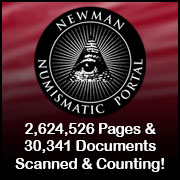
About UsThe Numismatic Bibliomania Society is a non-profit association devoted to the study and enjoyment of numismatic literature. For more information please see our web site at coinbooks.org SubscriptionsThose wishing to become new E-Sylum subscribers (or wishing to Unsubscribe) can go to the following web page link MembershipThere is a membership application available on the web site Membership Application To join, print the application and return it with your check to the address printed on the application. Print/Digital membership is $40 to addresses in the U.S., and $60 elsewhere. A digital-only membership is available for $25. For those without web access, write to: Charles Heck, Treasurer AsylumFor Asylum mailing address changes and other membership questions, contact Chuck at this email address: treasurer@coinbooks.org SubmissionsTo submit items for publication in The E-Sylum, write to the Editor at this address: whomren@gmail.com
BUY THE BOOK BEFORE THE COINSale Calendar
|
- WAYNE'S WORDS: THE E-SYLUM AUGUST 23, 2020
- NBS AUCTION AND GENERAL MEETING
- NBS BIBLIOTALK PODCAST INTERVIEWS DAN HAMELBERG
- NEW BOOK: PROVISIONAL COINS OF EL SALVADOR
- 2020 NUMISMATIC LITERARY GUILD AWARD WINNERS
- COIN IMAGING FORMAT: NUTILT
- IN GOD WE TRUST ON U.S. PAPER MONEY
- VIDEO: JERRY COHEN INTERVIEW
- NEW DOCUMENTARY: WILL WE STOP MAKING CENTS?
- NOTES FROM E-SYLUM READERS: AUGUST 23, 2020
- MORE ON DONALD GROVES PARTRICK
- AN ENGRAVED CIVIL WAR ID DISC
- PORTRAITS OF MINT DIRECTOR ROBERT PATTERSON
- ON NEARLY ALL-MALE NUMISMATIC EVENTS
- THE HISTORY OF THE FREEDMAN'S BANK
- VOCABULARY TERMS: MOLD, MOLDING
- RIGHT REVEREND EDMOND MARIE OBRECHT (1852-1935)
- GEORGE BUSH COIN DESIGNER ELANA HAGLER
- ANCIENT COINS IN EARLY AMERICAN AUCTIONS
- DAVISSON'S E-AUCTION 36 ANCIENTS
- ROBINSON ANCIENT COIN SALE 113 SELECTIONS
- CLASSICAL NUMISMATIC GROUP SALE 115 ANNOUNCED
- MORE HOLABIRD AUGUST 2020 SALE SELECTIONS
- NUMISMATIC NUGGETS: AUGUST 23, 2020
- COIN CASTING AT COLONIAL WILLIAMSBURG
- THE HEATON MINT SERIES OF CHINESE COINS
- THE HISTORY OF HOBO NICKELS
- DO WE CALL THEM SO-CALLED DIMES?
- AN ESSAY ON GAMING COUNTERS
- UTAH'S GOLDBACK ALTERNATIVE CURRENCY
- LOOSE CHANGE: AUGUST 23, 2020
- MR. SQUIRREL'S TIME-TRAVELING COIN ENVELOPES
Click here to access the complete archive
Click here to unsubscribe (scroll down)
To comment or submit articles, reply to whomren@gmail.com
Content presented in The E-Sylum is not necessarily researched or independently fact-checked, and views expressed do not necessarily represent those of the Numismatic Bibliomania Society.
WAYNE'S WORDS: THE E-SYLUM AUGUST 23, 2020
 New subscribers this week include:
Larry Hall and
William Nawrocki.
Welcome aboard! We now have 6,550 subscribers.
New subscribers this week include:
Larry Hall and
William Nawrocki.
Welcome aboard! We now have 6,550 subscribers.
Thank you for reading The E-Sylum. If you enjoy it, please send me the email addresses of friends you think may enjoy it as well and I'll send them a subscription. Contact me at whomren@gmail.com anytime regarding your subscription, or questions, comments or suggestions about our content.
This week we open with updates from NBS, one new book, NLG 2020 award winners, updates from the Newman Numismatic Portal, a new documentary, and more.
Other topics this week include the In God We Trust motto, an engraved Civil War ID disc, Mint Director Robert Patterson, the Freedman's Bank, the George H.W. Bush coin designer, ancient coins galore, coin casting, Hobo Nickels, So-Called Dimes, gaming counters, and Goldbacks.
To learn more about numismatic bibliophile Dan Hamelberg, the provisional coins of El Salvador, a new coin image format, dealer Jerry Cohen, collector Don Partrick, an extremely rare pantaleon soter, the Heaton Mint, ancient myths on Roman coins, and Mr Squirrel's time-traveling coin envelopes, read on. Have a great week, everyone!
Wayne Homren
Editor, The E-Sylum
NBS AUCTION AND GENERAL MEETING
REMINDERS! The 2020 Numismatic Bibliomania Society Benefit Auction is open for bidding. Also, the NBS annual General Meeting is coming up on Monday, August 31, 2020. -Editor
Bid on great numismatic literature and donate to the NBS at the same time! This year's NBS Fundraising Auction is entirely by mail bid this year. Download the catalogue and send your bids to df@numislit.com by 6:00PM on Monday, August 31, 2020 and help support numismatic literature.
To View the NBS 2020 Benefit Auction Catalogue
https://www.numislit.com/pdfs/NBSAuction2020.pdf
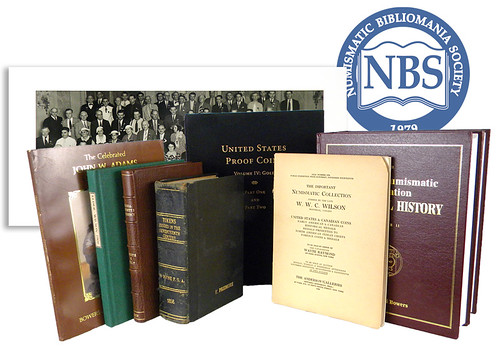
NBS General Meeting August 28
The NBS will be holding our General Meeting during the Newman Numismatic Portal Symposium via Zoom on August 28, 2020 at 11:00AM EDT. Registration includes links to all presentations August 28–29, including those by many NBS members.
To Register for the Symposium:
https://www.eventbrite.com/e/nnp-symposium-2020-registration-107734855854
To Download the Symposium Schedule:
https://drive.google.com/file/d/19GsRYKJ1fQCzpRhuwRxi7dptHGlfd6eH/view?mc_cid=47a3379fde&mc_eid=5362059be6

NBS BIBLIOTALK PODCAST INTERVIEWS DAN HAMELBERG
The latest episode of the Numismatic Bibliomania Society podcast is now available for listening. -Editor
NBS Podcast Interviews Dan Hamelberg
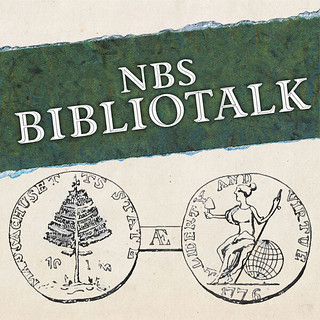 The latest installment of Bibliotalk, the NBS quarterly podcast, has been added to the NBS website (coinbooks.org). Additionally, Bibliotalk may be accessed via other popular podcast platforms such as Spotify, iHeart, and many others.
The latest installment of Bibliotalk, the NBS quarterly podcast, has been added to the NBS website (coinbooks.org). Additionally, Bibliotalk may be accessed via other popular podcast platforms such as Spotify, iHeart, and many others.
In this episode, Lianna Spurrier interviews Dan Hamelberg, book collector extraordinaire. Hamelberg discusses the genesis and formation of his numismatic library, interweaving stories about collecting coins as a child and his current focus on first year of issue U.S. coins. Dan talks about the impact of the Internet on book collecting, along with a few of his favorite items from the library. This is not to be missed – almost as good as spending an hour in the Hamelberg library itself!
NBS is pleased to announce that the frequency of Bibliotalk will move from quarterly to bi-monthly. Feel free to share feedback, or ideas for future episodes with NBS Vice-President Len Augsburger at leonard.augsburger@wustl.edu.
Link to Dan Hamelberg interview on Coinbooks.org (see left column of page): https://www.coinbooks.org/
Well worth listening to! I enjoyed this on my drive home from work the other day. I've known Dan for a lot of years - his stories are great, and his advice spot-on. Check it out. -Editor
NEW BOOK: PROVISIONAL COINS OF EL SALVADOR
There's a new book in English on the provisional coins of El Salvador in the Central American Federation. Here's the announcement. Congratulations to the authors. -Editor
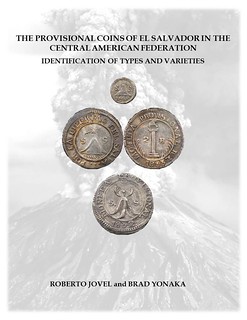 The Provisional Coins of El Salvador in the Central American Federation – Identification of Types
and Varieties
The Provisional Coins of El Salvador in the Central American Federation – Identification of Types
and Varieties
by Roberto Jovel and Brad Yonaka
ISBN: 978-0-9986825-2-5
90 pp. | 8 ½ x 11 inch softbound
This book builds on work previously published by the renowned El Salvadorian numismatist Roberto Jovel, focusing on the provisional silver coins struck by the State of El Salvador during the years 1828-1835, when it was part of the Central American Federation. These crudely made issues were minted in response to severe monetary shortages experienced during the chaotic and economically difficult years of the Federation, and testament to the confrontational and often openly hostile stance that existed between the state government of El Salvador and the Federal government, seated initially in Guatemala. As such, some of these coins are understood to be obsidional (siege) issues, and others as necessity coins given the economic context. The book's foreword was written by the esteemed numismatist Brian Stickney.
The book gives a detailed history of events during these years, and the coin issues are woven into the narrative as chronologically germane. Co-author Brad Yonaka brings into play a detailed die pairing study to accompany mention of the types, which include five different denominations and a plethora of design changes. All in all a total database of 227 coins are considered, resulting in 54 distinct types.
The title mentioned in this article is the version in English, self-published by Brad Yonaka, and delayed from its original publication date due to quarantine. An identical version, in Spanish, is set to be published by Roberto Jovel later this year and has likewise been delayed.
Price: $20 + $3 shipping within USA for total of $23. Overseas shipping please inquire. Order by sending personal check to:
Agorocu Consulting Inc.
PO Box 41515
Long Beach, CA 90853
Or payment by Paypal to: acanthite@live.com
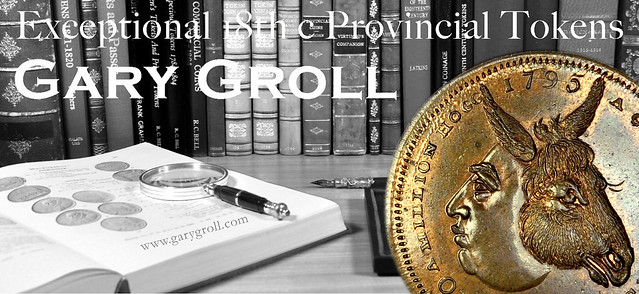
2020 NUMISMATIC LITERARY GUILD AWARD WINNERS
The Numismatic Literary Guild (NLG) is a separate organization from ours, the Numismatic Bibliomania Society (NBS). But we share a love of the numismatic hobby and numismatic research and writing in particular. This NLG press release lists the NLG award winners for 2020. Congratulations to all of the winners, many of whom are E-Sylum and NBS regulars. I've added images of some of the books were announced or reviewed in earlier E-Sylum issues. See the links below for more information about adding these award-winners to your numismatic library. -Editor
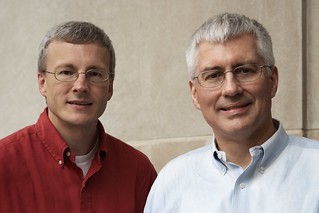 Augsburger and Orosz Selected As 2020
Numismatic Literary Guild Clemy Winners
Augsburger and Orosz Selected As 2020
Numismatic Literary Guild Clemy Winners
Respected researchers and award-winning numismatic authors Len Augsburger and Joel Orosz have received yet another prestigious award. They have been selected as the joint 2020 recipients of The Clemy, the highest honor given by the Numismatic Literary Guild (www.NLGonline.org).
"The Clemy is a coveted, annual award presented in recognition of writing skill, dedication to numismatics, sense of humor and dedication to the Numismatic Literary Guild," explained NLG Executive Director Ron Guth.
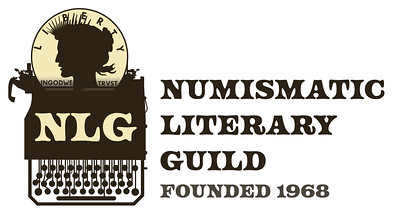
Founded in 1968, the NLG is a nonprofit organization open to any editors, reporters, authors, writers, catalogers, webmasters, bloggers or producers of audio or video involving all forms of money, medals, tokens and other numismatic collectibles. Information about applying for NLG membership is available online at www.NLGonline.org/membership.
The organization's annual awards presentation, known as "The Bash," was scheduled for August 6, 2020 in conjunction with the American Numismatic Association's Pittsburgh World's Fair of Money. However, because of the convention's cancelation due to the pandemic, the NLG awards were announced this year with an online video at www.youtube.com/watch?v=aDDxpw09zAI&t=154s. The video was produced by NLG member Charles Morgan of CoinWeek.com.
Here is a list of the 2020 award categories and winner as compiled by NLG awards coordinator David W. Lange.
1. BEST SPECIALIZED BOOKS
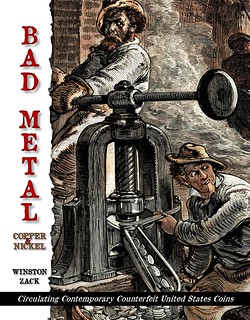
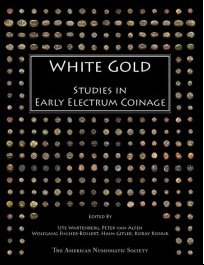
a. United States or Early American Coins
Winston Zack – Bad Metal: Copper and Nickel Circulating Contemporary Counterfeit
United States Coins
b. Ancient or Medieval Coins (pre-1500)
Peter Van Alfen & Ute Wartenberg – White Gold: Studies in Early Electrum Coinage
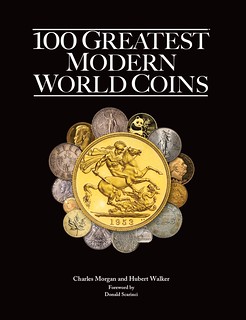
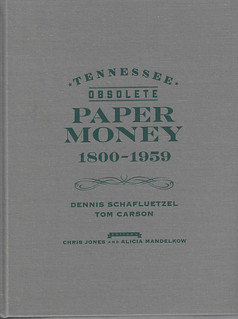
c. World Coins (1500 to Date)
Charles Morgan & Hubert Walker – 100 Greatest Modern World Coins
d. United States Paper Money
Dennis Schafluetzel & Tom Carson – Tennessee Obsolete Paper Money 1800-1959
e. World Paper Money
(no entries)
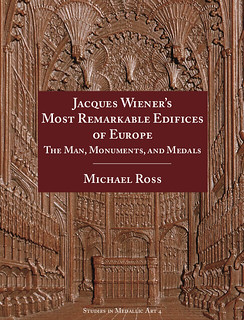
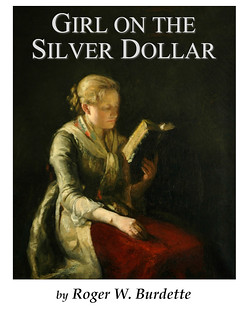
f. Tokens & Medals
Michael Ross – Jacques Wiener's Most Remarkable Edifices of Europe
g. Numismatic Investment or Marketplace
(no entries)
h. Numismatic History or Personalities
Roger W. Burdette – Girl on the Silver Dollar
2. BOOK OF THE YEAR
Daryl J. Haynor – United States Classic Gold Coins of 1834-1839

3. NUMISMATIC FEATURE ARTICLES
a. Early American Coins
Christopher McDowell & Julia Casey – The Authentic Fugio Restrike Dies – Journal of Early
American Numismatics
b. U.S. Coins (1792 to Date)
Tom DeLorey & Dan Owens – Not a Ghost of a Chance – The Numismatist
c. Ancient or Medieval Coins (pre-1500)
Thomas A. Palmer – From the Sublime to the Ridiculous – The Numismatist
d. World Coins (1500 to Date)
Lianna Spurrier – Japanese Bar Money – CoinWeek.com
e. U.S. Paper Money
Jim Wells – Mind Your Business – The Numismatist
f. World Paper Money
(no entries)
g. Tokens & Medals
David Schenkman – Numismatics of the Civil War Era – Civil War Token Journal
h. Numismatic Investment or Marketplace
Steve Roach – Evaluating Quality – Coin World
i. Numismatic History or Personalities
Q. David Bowers – John J. Ford: A Life in Three Portraits – Journal of Early American
Numismatics
j. James L. Miller Memorial Award - Article or Story of the Year
Christopher McDowell & Julia Casey – The Authentic Fugio Restrike Dies – Journal of Early
American Numismatics
4. NUMISMATIC COLUMNS
a. Early American Coins
Ray Williams – Early American Money – The Numismatist
b. U.S. Coins (1792 to Date)
David W. Lange – USA Coin Album
c. Ancient or Medieval Coins (pre-1500)
NGC Ancients – NGC eNews
d. World Coins (1500 to Date)
Peter Anthony – Chinese Coins – NGC eNews
e. Paper Money
Wendell Wolka – Paper Money – The Numismatist
f. Tokens & Medals
David Schenkman – Tokens and Medals – The Numismatist
g. Numismatic Investment or Marketplace
Steve Roach – Coin Values Market Analysis – Coin World
h. Ed Reiter Memorial Award For Best Column - Numismatic Publications
David Schenkman – Tokens and Medals – The Numismatist
i. The Maurice M. Gould Memorial Award for Best Column - Non-Numismatic Publications
ii. (no entries)
5. PERIODICALS
a. Best Investment Newsletter
Liberty's Outlook – Patrick A. Heller
b. Best Professional Periodical
COINage – Antoinette Rahn & Scott Travers, Editors
c. Best Club or Not-for-Profit Periodical – Large Circulation
The Numismatist – Barbara Gregory, Editor
d. Best Club or Not-for-Profit Periodical – Small Circulation
The Gobrecht Journal, Bill Bugert, Editor
6. WEBSITES
a. Best Online News Website
(no entries)
b. Best Dealer or Industry Website
Stack's/Bowers
c. Best Non-Trade Website
Newman Numismatic Portal
d. Best Numismatic Social Media Platform or Coin Collector Forum
Numismatic Guaranty Corporation
e. Best Blog
Scott Barman – Coin Collector's Blog
7. AUCTION OR FIXED-PRICE CATALOGS
a. Best U.S. Coin Auction Catalog
Heritage Auctions – FUN Platinum Night
b. Best World Coin Auction Catalog
Heritage Auctions – New York International Platinum Night
c. Best Paper Money Auction Catalog
Stack's/Bowers – The D. Brent Pogue Collection VI
d. Best Book or Exonumia Auction Catalog
Stack's/Bowers – The John W. Adams Collection
8. AUDIO-VISUAL
a. Radio
Patrick A. Heller – Things You Know that aren't So – 1320 WILS
b. Audio
Coin World Podcast
c. Television
(no entries)
d. Short Video – Commercial or Non-Commercial
Lianna Spurrier – Getting to Know Eric P. Newman – Newman Numismatic Portal
e. Long Video – Commercial or Non-Commercial
(no entries)
f. Still Photography
Philip Arnold
g. Software or App
Heritage Live
9. SPECIAL AWARDS
a. Lee Martin Founder's Award - Best All-Around Portfolio
Steve Roach
b. Clement F. Bailey Memorial Award
(no entries)
c. The Ribbit
Jeff Garrett
d. The Clemy
Len Augsburger and Joel Orosz
To watch the 2020 NLG Writers Awards Ceremony on YouTube, see:
Numismatic Literary Guild 2020 Writers Awards Ceremony
(https://www.youtube.com/watch?v=aDDxpw09zAI&t=154s)
To read the earlier E-Sylum articles, see:
NEW BOOK: BAD METAL
(https://www.coinbooks.org/v22/esylum_v22n31a07.html)
NEW BOOK: WHITE GOLD: EARLY ELECTRUM COINAGE
(https://www.coinbooks.org/v23/esylum_v23n05a02.html)
NEW BOOK: 100 GREATEST MODERN WORLD COINS
(https://www.coinbooks.org/v22/esylum_v22n52a02.html)
BOOK REVIEW: 100 GREATEST MODERN WORLD COINS
(https://www.coinbooks.org/v23/esylum_v23n03a04.html)
NEW BOOK: TENNESSEE OBSOLETE PAPER MONEY
(https://www.coinbooks.org/v22/esylum_v22n30a05.html)
NEW BOOK: JACQUES WIENER'S REMARKABLE MEDALS
(https://www.coinbooks.org/v22/esylum_v22n40a05.html)
NEW BOOK: GIRL ON THE SILVER DOLLAR
(https://www.coinbooks.org/v22/esylum_v22n38a02.html)
BOOK REVIEW: GIRL ON THE SILVER DOLLAR
(https://www.coinbooks.org/v22/esylum_v22n40a07.html)
NEW BOOK: U.S. CLASSIC GOLD COINS OF 1834-1839
(https://www.coinbooks.org/v23/esylum_v23n12a02.html)
BOOK REVIEW: U.S. CLASSIC GOLD COINS OF 1834-1839
(https://www.coinbooks.org/v23/esylum_v23n26a07.html)

COIN IMAGING FORMAT: NUTILT
On August 20, 2020 the David Lawrence Rare Coins blog announced a new coin image format that's worth a look. -Editor
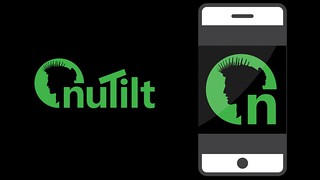 David Lawrence Rare Coins (DLRC) and nuTilt Imaging are excited to introduce a brand-new imaging technology to the hobby of numismatics. NuTilt is a patent-pending process that brings coin imaging to life! The limitation of coin images today is that they are static; nuTilt breaks this barrier, showing how the light catches all areas of a coin just like it does when you tilt it in your palm.
David Lawrence Rare Coins (DLRC) and nuTilt Imaging are excited to introduce a brand-new imaging technology to the hobby of numismatics. NuTilt is a patent-pending process that brings coin imaging to life! The limitation of coin images today is that they are static; nuTilt breaks this barrier, showing how the light catches all areas of a coin just like it does when you tilt it in your palm.
According to John Brush, President of DLRC, "In a world where static images can only go so far, the next frontier in imaging technology is to experience the look of a coin as if it is in your hand. Between the coin industry adjusting to life without large gatherings, and the cultural expansion of interest in digital immersion, this seemed like the perfect opportunity to fill a need for the hobby while modernizing the art of collecting." Brush continues, "As a service to collectors, adding nuTilt to the DLRC website was a no-brainer."
With the revolutionary iOS and Android smartphone apps, launching in September, the user can tilt their phone or tablet in any direction to capture the "in-hand" full virtual experience. Additionally, the zoom feature allows the user to inspect all parts of the coin to a degree of detail not possible with a static image. According to Jason Smith, Vice President of DLRC, "We are excited to launch nuTilt imaging exclusively to DLRC customers over the coming months. We have always strived to give our customers the best possible images available to help them make the most informed buying decisions. Partnering with nuTilt is another advanced step in this direction. The nuTilt process sheds light on detail and accuracy never achieved before."
The technology was dreamed up by Paul Price, a programmer and collector, over the past decade. After years of experimenting, new developments in mobile phones and computers have allowed the pieces to finally fit together with the launch of this software. According to Price, "Partnering with DLRC was perfect fit for nuTilt. With their focus on working with the collector, bringing innovation to the hobby, and a reputation of honesty and integrity amongst their customer base, it became very clear that they were the right folks to work with." Price continues, "While there is still so much more that we think is possible with nuTilt, we're excited to finally start bringing coins to "life".
At this time, nuTilt imaging will be exclusively used through the DLRC and nuTilt websites, with the ultimate goal of making the technology available to collectors in 2021. If you are looking to sell your coins and would like to have them imaged with nuTilt, please contact DLRC at coins@davidlawrence.com.
The nuTilt image is an animated .gif of the coin being tilted like you would do with it in your hand to see light reflection from multiple angles. With silver dollars, it's how you see the "cartwheel effect" generated by flow lines. Len Augsburger told me Heritage had something similar on their site a few years ago.
The nuTilt smartphone app should be an even better option for coin viewing, since it would be interactive. If I understand this correctly, your device's accelerometer would tell the app how your phone is tilted, and it can adjust the photo accordingly, creating a close-to-real-life coin viewing experience that responds to how you're holding the virtual coin.
Of course, it's still an artificial experience, but a more immersive and information-rich one. Much still depends on the skill of the photographer to light the coin. Maybe controlling the lighting is part of their process, and perhaps that will be an adjustable feature in the future.
Every new technology runs the risk of becoming the hot fad for a moment then disappearing from view. But I think this concept has legs and will be a direction we'll see the hobby heading toward. As with nearly every new technology it's expensive at first, so you'll only see this being used with higher-valued coins. Time will tell if its use becomes more ubiquitous. Follow the links below to view a few coins in the nuTilt format.
Without the app these images come up in an "Auto Swirling" format. Staring too long could give some people a headache. But just toggle the Auto Swirling button at the top to stop and restart the motion. This is a better viewing experience and will become natural on a smartphone where the tilt of your hand will translate to the tilt of the image. Check it out and let us know what you think. -Editor
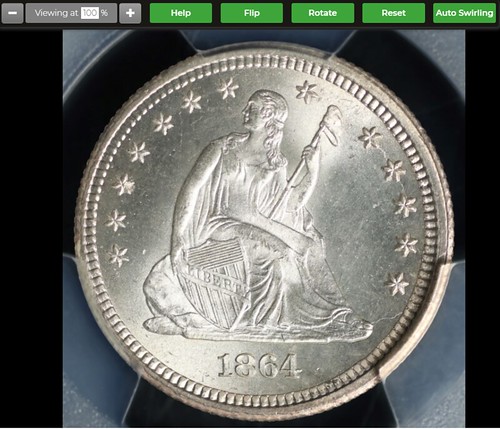
To view some coins in the nuTilt format, see:
1840 Large Cent
(https://www.davidlawrence.com/tiltview.html?cert_id=36087810&referrer_id=dl)
1858 Flying Eagle Cent
(https://www.davidlawrence.com/tiltview.html?cert_id=36658470&referrer_id=dl)
1877 Proof Shield Nickel
(https://www.davidlawrence.com/tiltview.html?cert_id=38002667&referrer_id=dl)
1805 Quarter
(https://www.davidlawrence.com/tiltview.html?cert_id=36607405&referrer_id=dl)
1864 Quarter
(https://www.davidlawrence.com/tiltview.html?cert_id=24809419&referrer_id=dl)
To read the complete article, see:
Introducing nuTilt!
(https://blog.davidlawrence.com/introducing-nutilt/)

IN GOD WE TRUST ON U.S. PAPER MONEY
The latest addition to the Newman Numismatic Portal is a Chase Manhattan Bank Museum pamphlet on the In God We Trust motto. Project Coordinator Len Augsburger provided the following report. -Editor
In God We Trust on U.S. Paper Money
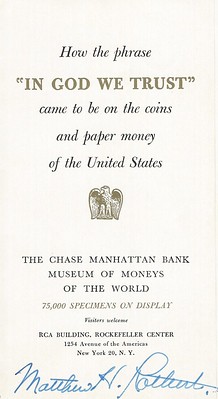 The demise of bank-operated money museums in the United States (Chase Manhattan, Detroit National, etc.) is a well known phenomenon. This week we present a brochure from the Chase Manhattan Bank Museum of Moneys of the World, which explains how the phrase "In God We Trust" came to appear on U.S. paper money. Remarkably, while the motto was added to coins in 1865, nearly a century elapsed before it was added to paper money.
The demise of bank-operated money museums in the United States (Chase Manhattan, Detroit National, etc.) is a well known phenomenon. This week we present a brochure from the Chase Manhattan Bank Museum of Moneys of the World, which explains how the phrase "In God We Trust" came to appear on U.S. paper money. Remarkably, while the motto was added to coins in 1865, nearly a century elapsed before it was added to paper money.
The Chase Manhattan Bank, c. 1960, exhibited the famous 1861 letter from Rev. Mark Watkinson to Treasury Secretary Salmon Chase urging the U.S. Mint to add "In God We Trust" to the nation's coinage. Matt Rothert, ANA dignitary, who spearheaded the effort to add "In God We Trust" to paper money, signed this particular example, which originates from the Newman collection. Thanks to Bill Bierly for relating the background of this brochure.
Link to "In God We Trust on U.S. Paper Money" brochure on Newman Portal:
https://nnp.wustl.edu/library/book/587112
VIDEO: JERRY COHEN INTERVIEW
These are selections from the David Lisot Video Library that feature news and personalities from the world of coin collecting. David has been attending coin conventions since 1972 and began videotaping in 1985. The Newman Numismatic Portal now lists all David's videos on their website at:
https://nnp.wustl.edu/library/multimediadetail/522852
Here's an interview with dealer Jerry Cohen. -Editor
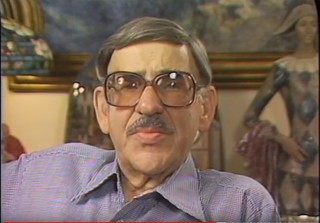 PNG Living History: Jerry Cohen, October 11, 1988.
PNG Living History: Jerry Cohen, October 11, 1988.
VIDEO: 37:35.
Sponsored by the Professional Numismatists Guild.
Another legendary coin dealer is interviewed by David Lisot. David goes to the home of Jerry Cohen in Beverly Hills, California to talk about the early days of numismatics. Jerry talks about Sol Kaplan, Dr. Sheldon, Al Overton, B. Max Mehl, Eric Newman, John Ford, Wayte Raymond, Charlie Green, Aubrey Bebee, Earl Parker, OL Harvey, and Jake Bell along with many more. He talks about seeing eight 1894-S Barber dimes in a dealer's store. He tells tales of 1907 Ultra High Relief $20 gold pieces. Jerry was of part of the formation of the Professional Numismatists Guild and shares the others responsible. He shows a picture of a PNG banquet from the 1950's and names to attendees. Great archival numismatic video!
An excerpt of the video is available for viewing on the Coin Television YouTube Channel at:
https://youtu.be/8K8oSJCoH9o

NEW DOCUMENTARY: WILL WE STOP MAKING CENTS?
This Washington Post article describes a new documentary film about the "penny". Dealer Julian Leidman is among the interviewees. -Editor
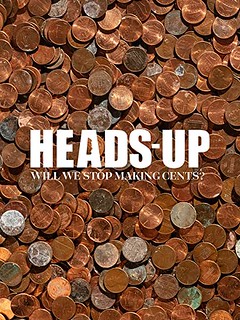 In 2017, wife-and-husband documentary filmmakers Jamie Kovach and Zach Edick embarked on an epic eight-week road trip across North America. Their quarry? The most worthless thing you can find in a cash register or a coin purse: the penny.
In 2017, wife-and-husband documentary filmmakers Jamie Kovach and Zach Edick embarked on an epic eight-week road trip across North America. Their quarry? The most worthless thing you can find in a cash register or a coin purse: the penny.
The result is "Heads-Up: Will We Stop Making Cents?" Their 68-minute documentary is by turns thoughtful and goofy, featuring interviews with everyone from former directors of the U.S. Mint to the tetchy head of a Virginia mail-order vinyl company who was so irritated by local government that he paid the tax on two new vehicles entirely in pennies — five wheelbarrows full.
When the couple saw a magazine article about seigniorage — the difference between the cost to produce a coin and what it's worth — they thought the back-and-forth over whether to abolish the penny might make a good subject.
"It's not particularly controversial, but it would literally affect every American in every walk of life," said Jamie, 34. "It's a fun way to do a portrait of America as a whole through the lens of a really simple issue."
They did some research, decided whom to interview, set up meetings, then set off. At the end of every interview, they would ask if there was anyone else they should speak with, a trick Jamie learned when she was at Blair's Silver Chips newspaper.
"There's a wonderful community of people that work within the field of coinage," said Jamie, who lives with Zach and their daughter, Lucy, in Austin.
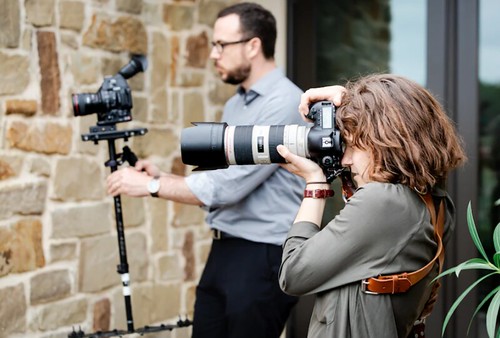
They wound up talking to such diverse figures as the chief executive of Coinstar and a New York City ornithologist who says that spotting birds is good practice for finding coins on the sidewalk. And the couple stopped in Canada, which got rid of its penny in 2012 and suffered no apparent ill effects.
Also in the film is Julian Leidman, a numismatist who runs Bonanza Coins in Silver Spring.
"I remember going in there as a kid," said Jamie. "Montgomery Donuts was nearby. We'd get a doughnut and look at coins at the coin store. I'd buy a wheat penny."
Their movie debuted in September at the Columbus Film Festival. It went up on Amazon Prime two weeks ago.
To read the complete article, see:
A new documentary flips over the lowly penny
(https://www.washingtonpost.com/local/a-new-documentary-flips-over-the-lowly-penny/2020/08/19/b61ad328-e22d-11ea-b69b-64f7b0477ed4_story.html)
To watch, see:
Heads-Up: Will We Stop Making Cents?
(https://www.amazon.com/Heads-Up-Will-Stop-Making-Cents/dp/B08D617XKS/ref=sr_1_1)
NOTES FROM E-SYLUM READERS: AUGUST 23, 2020
The Utility of a Penny
On the same topic is this reader note. -Editor
James McNally of Grosse Pointe Farms, MI writes:
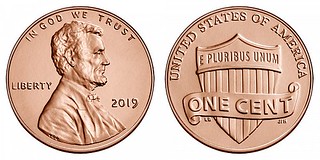 "Regarding the articles about whether the penny will survive the coronavirus, I have always felt that the worth of a cent goes beyond the cost of its manufacture. The focus should be on its utility. A penny is only worth a penny and costs more than a penny to make, but it can be used millions of times as a penny without incurring any additional manufacturing costs. Its utility is more than a penny's worth, and more than the price of manufacturing it.
"Regarding the articles about whether the penny will survive the coronavirus, I have always felt that the worth of a cent goes beyond the cost of its manufacture. The focus should be on its utility. A penny is only worth a penny and costs more than a penny to make, but it can be used millions of times as a penny without incurring any additional manufacturing costs. Its utility is more than a penny's worth, and more than the price of manufacturing it.
"Consider credit cards. It costs money to make and send credit cards to bank customers, but they have absolutely no value as a slab of plastic. Should they stop making them? Of course not - the value of the credit card is not in the plastic but in its utility."
Good point. Thanks! -Editor
Whitman Folders and Albums Book Update
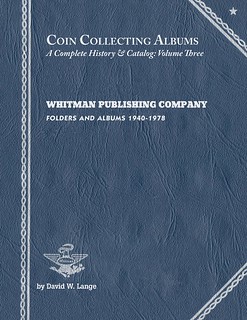 Regarding his new book Coin Collecting Albums, A Complete History & Catalog: Volume Three, Whitman Publishing Company Folders and Albums 1940-1978, author David Lange writes:
Regarding his new book Coin Collecting Albums, A Complete History & Catalog: Volume Three, Whitman Publishing Company Folders and Albums 1940-1978, author David Lange writes:
"The books shipped to me Friday, so I should have them around Wednesday and will be filling orders by the end of next week."
Great news! I'm looking forward to this one. See the earlier articles for ordering information. -Editor
To read the earlier E-Sylum articles, see:
NEW BOOK: COIN COLLECTING ALBUMS, VOLUME THREE
(https://www.coinbooks.org/v23/esylum_v23n25a03.html)
WHITMAN COIN FOLDERS AS COLLECTIBLE ITEMS
(https://www.coinbooks.org/v23/esylum_v23n33a14.html)
THE BOOK BAZARRE
MORE ON DONALD GROVES PARTRICK
Dave Hirt writes:
"While reading of the passing of Donald Groves Partrick it was mentioned that he was a generous man. I can attest to that. During the time that I was Secretary-Treasurer of the Numismatic Bibliomania Society Groves for several years sent a $100 check for his annual dues which at that time were 10 or 15 dollars. The first time that I received that I was quite surprised. No one had ever done that before. I always remembered his generosity."
Jim Neiswinter writes:
"At the 2005 EAC convention in Annapolis, Maryland the featured speaker was ANS curator Robert Hoge. His talk came right after the dinner on Friday night. ANS director Ute Wartenberg also attended. An unplanned visitor showed up just before dinner. It was ANS president Don Partrick. A seat at the head table was quickly added. It was not until the next morning that I had my one and only interaction with Don Partrick.
"I was driving to breakfast with my friend Dan Trollan. We drove down the hotel driveway to the main street outside the Radisson. The hotel is on the outskirts of Annapolis close to highway 301. At the end of the driveway I saw Don standing there, suitcase in hand. I stopped and asked him if he wanted to go to breakfast with us. He said no because he was trying to hail a cab to take him to the airport. This was not New York City where he could easily get a cab on the street. I offered to drive him to BWI about 20 minutes away. (Dan passed on the airport trip and went on to breakfast.)
"I figured that I could talk to Don about his collection. I figured wrong. He was a clam. After several attempts trying to engage him in conversation about coins I gave up. We did talk about Garden City N.Y., a town on Long Island where he once lived and the town where I grew up. Soon we arrived at BWI and Don made his plane back to NYC. When I told this story to people at the ANS, they all got a chuckle out of it, and said: "that's Don"."
Alan V Weinberg provided the following remembrances. Thanks! Image courtesy Pete Smith. -Editor
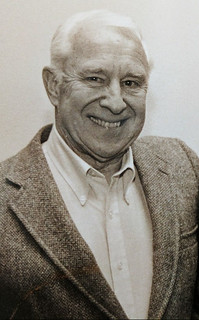 I knew Don Partrick rather well. He was far from reclusive and eager to discuss, although not show, his numismatic acquisitions. Possibly due to his fear of theft but more likely a fear of switching. Initially, he was using John Ford as his agent until Ford acquired Donald Miller's Hard Times token collection intact for Don. But Ford went thru it first, selected upgrades for his own collection and switched in his lower grade tokens (ala Dr. Sheldon) and then sold Don the collection. Word got back to Don. Big
mistake.
I knew Don Partrick rather well. He was far from reclusive and eager to discuss, although not show, his numismatic acquisitions. Possibly due to his fear of theft but more likely a fear of switching. Initially, he was using John Ford as his agent until Ford acquired Donald Miller's Hard Times token collection intact for Don. But Ford went thru it first, selected upgrades for his own collection and switched in his lower grade tokens (ala Dr. Sheldon) and then sold Don the collection. Word got back to Don. Big
mistake.
Don then used G. Jon Hanson, once a Ford protege and very much like Ford in personality, as his numismatic agent in both private and auction transactions. Don would uniquely sit at auctions in the front of the room, with his back to the auction podium. Hanson would sit opposite Don, but in the extreme rear row and bid for Partrick. Likely for two reasons. Don's opinion of value was often imprecise and Hanson, he believed, knew more about value. Also Don believed if he himself bid, he'd be bid up "for fun". He thought this would not happen using Hanson as his agent who often sat at the rear adjacent to all the other actively bidding prominent dealers, all still active today.
Well, that arrangement didn't work either as I, very often sitting one row in front of Hanson, was privy to whispers like "bid him up" and the like. A lot of laughter and snickering.
Prior to adopting Hanson as an auction agent, Don used to execute bids on his own, most notably on historic head to head auction floor battles with John Roper, a shipbuilder from Norfolk, Va. Both gentlemen had substantial war chests and an interest in rare colonial coins. Roper was 10-15 years older than Don so Don often finally yielded his bids to Roper. When Roper passed and his collection was sold by Stacks in NYC in December 1983, Don was able to acquire the great colonial rarities at the Roper sale. I was there and won some myself.
As an example of Don's predilection vs exhibiting what he owned, while Don was ANS President, curator John Kleeberg organized an ANS conference exhibit and plated book of Massachusetts colonial silver to which were loaned coins from my collection, Terranova, Hain, etc. Partrick refused to loan or picture his significant Massachusetts silver for this ANS conference. To my knowledge, not once did he ever exhibit anything. And his unease with showing his CWTs to the CWT maven Steve Tanenbaum, as mentioned in another article recently, attests to that.
To read the earlier E-Sylum articles, see:
DONALD G. PARTRICK (1926-2020)
(https://www.coinbooks.org/v23/esylum_v23n33a10.html)
DONALD G. PARTRICK COLLECTION SALES ANNOUNCED
(https://www.coinbooks.org/v23/esylum_v23n33a20.html)
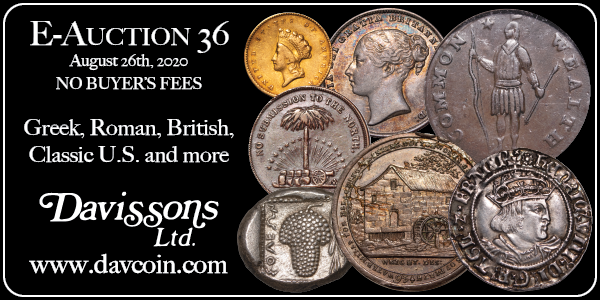
AN ENGRAVED CIVIL WAR ID DISC
Brian Bell of Geoffrey Bell Auctions asked if anyone could help with this new auction acquisition. As it happens my friend Tom Kays has one of these (uninscribed) and he kindly provided the following writeup. -Editor
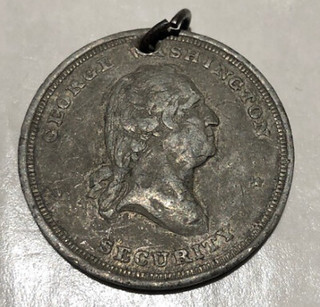
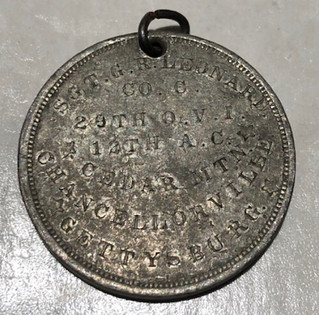
Engraved ID discs are unique items invested with personal history beyond the medal's generic image and legends. Those owned by a soldier layer military history of the unit the soldier served under on top of typically scant personal history. We may find and can read accounts of what hardships and historic scenes the person wearing the disc must have seen as a member of a fighting unit. Counterfeit ID disks are known but they typically list semi-famous folks killed-in-action, making it hard to refute whether the ID was theirs during the war or a complete fantasy made for collectors of items once owned by famous folks.
This disk is listed in Neil Musante's Medallic Washington, Volume 1, Page 320., as "GW-262." The obverse die with George Washington and "SECURITY" was created by Robert Lovett Jr. The obverse die survived long after the Civil War and was used by Thomas Elder as a model for a WW I dog tag that was not adopted by the Army, according to Neil Musante. These artifacts were not called "dog tags" until WW I. The reverse with four stars would be blank until engraved.
This Federal ID Disc was struck in pewter or white metal, is holed as most all were, and has an iron bale ring for suspension. Engraved upon the reverse is:
Co. C.
29 TH O. V. I.
12 TH A. C.
CEDAR MTN.
CHANCELLORVILLE
GETTYSBURG.
Having battle honors on an ID disc is something that typically happened late in the war and may indicate the item is a post-war issue, made for reunions and Grand Army of the Republic (GAR) functions. According to Wikipedia, the 29th Ohio Volunteer Infantry, in the Army of the Cumberland, were at Cedar Mountain, Chancellorsville, and Gettysburg at Culp's Hill. This disc might have been punch inscribed as Sgt Leonard recuperated from Gettysburg in late 1863 or later. Soldiers in the 29th Ohio volunteered to serve a three-year term. They were at Winchester, Virginia early in the war and saw action in Virginia.
After Gettysburg they reconstituted their muster and fought in the Atlanta campaign. Giles R. Leonard survived the war which is a good thing for him and for authenticity of this ID Disc. See National Tribune, A Balky Mule. A Prescription which Started him Running Down the Mountain, from May 14, 1891, Page 3., by Giles R. Leonard, 1st Lieutenant, 29th Ohio, (then living at Rushmore, Minnesota) who recounts his war experiences for the newspaper. All in all, this is the kind of provenance I like to find for ID disks that really brings history to life.
Thanks, Tom. This is a neat item. -Editor
PORTRAITS OF MINT DIRECTOR ROBERT PATTERSON
Joel Orosz passed along two posts from the American Philosophical Society blog about portraits of U.S. Mint Director Robert Patterson. Here's an excerpt. Thanks! -Editor
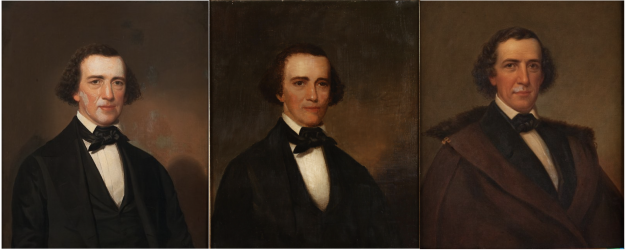
Patterson was a chemist, mathematician, and physicist. He was a professor at both the University of Pennsylvania and at the University of Virginia. He was the sixth director of the U.S. Mint in Philadelphia, belonged to the Academy of Natural Sciences, and helped found both the Franklin Institute and the Musical Fund Society of Philadelphia. He was elected to the APS in 1809, its youngest member to date at age twenty-two, and served as the APS Secretary, Vice President, and finally, as the President (1849-1854). He wrote an early history of the APS in 1842 and the APS also has a collection of his papers and notebooks.
In 1855, shortly after his death, the APS acquired its first portrait of Patterson directly from his wife, Helen. The artist of this portrait was Samuel F. Dubois, Patterson's nephew. According to family, the portrait was a "likeness, but fails to express the refinement & intelligence of the original." Finding it lacking, they donated it to the APS.
Dubois had studied at the Pennsylvania Academy of Fine Arts under Thomas Sully and had previously painted portraits of Patterson for both the U.S. Mint and the University of Virginia. In 1866, the Musical Fund Society commissioned Sully to paint a portrait of Patterson. Sully, an APS member since 1835, asked the APS for permission to copy the Dubois portrait in their collection. This is the portrait by Sully recently acquired by the APS.
The Dubois and Sully portraits not only allow for a comparative study, but also a study of portraits by a teacher and student. Comparing the two portraits allows us to see how artists working in different styles could paint a portrait of the same subject that results in very different representations of the sitter. Thomas Sully was an English-born artist who worked in an idealized, romantic style associated with British painting and favored by many patrons for expressing refinement. His brushstrokes, coloring, and lines were soft. (One wonders if Patterson's family would have thought Patterson appeared refined and intelligent enough in Sully's portrait – qualities they found lacking in Dubois' painting.)
Despite being a former student of Sully's, Dubois painted with crisper lines and more facial modeling. He was influenced by early photography and its realism. He had opened a daguerreotype studio in Doylestown by 1847. Dubois also was influenced by the traveling painters who worked in rural areas painting the middling classes. These artists are often called limners or folk artists to distinguish them from formally-trained artists (like Sully) who tended to cater to more elite patrons. These itinerant artists tended to paint with bolder colors and lines. Apparently, the Pattersons were not particularly impressed with this style, possibly because of its rural and middling class associations.
Patterson was painted many times-- at least three times by Dubois, once by Sully, and twice by Lambdin. He was also painted as a young man in a miniature by Benjamin Trott, now in the collection of the Philadelphia Museum of Art. Most of the portraits were painted for various institutions, who collected portraits of their founders or important benefactors and members to hang in esteemed portrait galleries. Portraits are often thought of primarily as family documents, but institutions were important to the commissioning and display of portraiture as well.
To read the complete articles, see:
The Many Portraits of Robert Patterson
(https://www.amphilsoc.org/blog/many-portraits-robert-patterson)
The Many Portraits of Robert Patterson (continued)
(https://www.amphilsoc.org/blog/many-portraits-robert-patterson-continued)
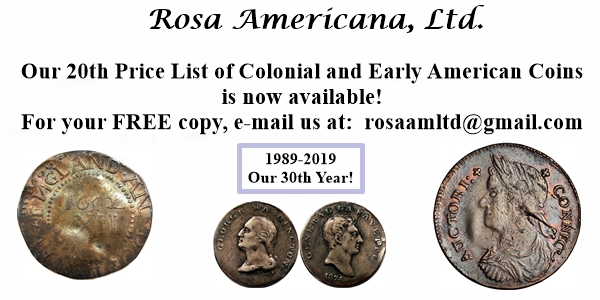
ON NEARLY ALL-MALE NUMISMATIC EVENTS
Former Executive Director of the American Numismatic Society Ute Wartenberg penned a thought-provoking article for the ANS Pocket Change blog this week. We're republishing it here with permission. -Editor
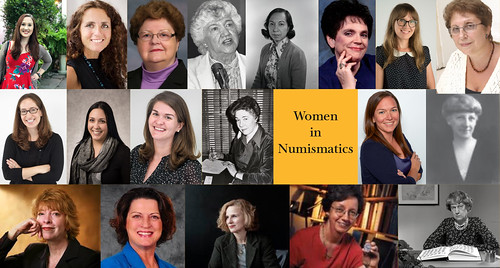
While August means for most people weekends on the beach, long summer days, or just hanging out, numismatists look forward to their annual pilgrimage to some convention center in places such as Rosemont, right next to O'Hare Airport. I refer of course to the annual World's Fair of Money, hosted by the American Numismatic Association, which was supposed to be in Pittsburgh this year. I have been going to this event for more than two decades, missing only a couple of shows. Over the years, one gets used to the routine: the same hotels, the same Hawaiian shirts that good friends from New York suddenly wear when they show up at the Summer ANA, visiting with numismatic friends. "Visiting with": that wonderful American, almost untranslatable phrase into English. I really miss our annual show right now.
I got used to the fact that women are very much in the minority in this setting. There are a lot of theories why this is the case. Women do not collect, or if they do collect, one hears, they collect coins, but only to an extent, as my many years in this field have shown me to be true. Women collectors—and even a few women dealers exist—but they have to fight for their place. However, all major numismatic organizations—the American Numismatic Association, the American Numismatic Society, and the National Numismatic Collections at the Smithsonian—were all run by women until last year, when I stepped down as Executive Director. Kim Kiick at the helm of the ANA has brought some much-needed calm and stability to an institution that had seen, prior to her appointment in 2013, more turnover in the position than I can remember; all but one (Ruthann Brettell) were men.
Ellen Feingold in the Smithsonian seems to have an entirely female department. The American Numismatic Society has had female curators and librarians since it very first appointment, from Agnes Baldwin Brett, Margaret Thompson, Nancy Waggoner, Rose Chan Houston, Carmen Arnold-Biucchi, Elizabeth Hahn Benge, and today Elena Stolyarik and Lucia Carbone. Over a century of women in numismatics, with research to show for it, as the many feet of publications on today's library shelves illustrate. Coin World in its heyday was run by two formidable editors for more than 50 years: Margo Russell and Beth Deisher. Barbara Gregory just completed 32 years as editor-in-chief of The Numismatist. So, it is hard to argue that there are no women in numismatics, who can think and write, know about coins, and run institutions.
If you have read this far, you might wonder why I am writing about this now. Sadly, there is no ANA Money Show, but this is made up by a large number of virtual events that are normally held in conjunction with the World's Fair of Money. Last week, an announcement for the first event made me raise my eyebrows when it arrived in my inbox: the Sundman Lecture Series on Women in Numismatics, run as a Webinar, has a group of lecturers, with some fascinating topics, but one lonely woman speaker, the rest all men. Really?
In addition to all this, one of the titles "Leading Ladies of Rome" has the ring of a 1940s movie, but not of a serious lecture about powerful empresses. Note to all men: the term "lady" annoys most women and is perhaps best used only when you are giving a formal speech somewhere and open with "ladies and gentlemen" or when used as a courtesy title (think First Lady of the United States) or in specific reference to fine manners (without patronizing overtones).
I was not the only woman (or man) in numismatics to notice the oddity, and perhaps irony, about a lecture series and the male group of presenters. I thought I would ignore this for now, but then a second such event was announced: this time a truly massive "manference", no less organized by the Newman Numismatic Portal. Do not get me wrong, this is an impressive event, and I love the organization and everything it supports. But does such an all-male event send the right signal to our field, including women and younger people? Manels ("male panels" for those not familiar with the term), as such events are known nowadays, should be a thing of the past by now. When I sent a draft of this blog text to Len Augsburger, he was very understanding to reach out to women and a more diverse audience. However, he points out that the NNP only funds this event. It was organized by the firm called Numismatic Marketing, which is run by a woman. Len also told me that women could have applied as speakers and that it was widely advertised. He has a point here. Women often just do not want to participate in these events, and the question is why. Clearly things need to change.
If numismatics wants to attract a wider audience, our organizations have to try to include more women and minorities, who often feel excluded from events such as coin shows, coin clubs, and our organizations. I know how difficult it is to bring women to numismatic events. What I have always heard is that there are just too many men. So, let's try do better next time. There are plenty of women researchers in numismatics, even if they do not shout as loud as the men. Let's not have another numismanel.
Point well taken.
Until I sold them off in advance of a move, I had a shelf full of books about Impressionist artist Mary Cassatt, a fellow Pittsburgh native. I enjoyed reading about her career and art-buying excursions with her friend and patron Louisine Havemeyer. The "numismanel" reference reminded me of a passage from a recent article about Cassatt's role in the Women's Suffrage movement. -Editor

On long afternoon walks, Havemeyer and Cassatt discussed everything that was wrong in the world and how they would fix it. Women's suffrage was essential. "If the world is to be saved, it will be the women who save it," Cassatt agreed. I like to picture them hiking the hilly countryside in their big hats and long skirts. Cassatt thin and walking with a cane, Havemeyer energetic and sure-footed, both of them gray-haired and elegant, a living Impressionist picture. And like Impressionism, though offering a pretty picture, these dames were rebels cackling beneath their parasols.
In 1912 Havemeyer had thrown a successful double-billing, an El Greco/Goya show, to raise money for suffrage. She decided she'd do it again with a modern master: Degas. But she realized a suffrage exhibit without a woman artist was wrongheaded. (Yes.) She asked if Cassatt would join Degas. More than willing, Cassatt liked the idea of poking a feminist finger in Degas's patriarchal eye.
Being on the right side of history is rarely easy. Cassatt's plan ran afoul of the politics of her family, including her brother Alexander who was more famous in their lifetimes as the powerful president of the Pennsylvania Railroad, one of the world's largest and wealthiest corporations of the day. -Editor
Cassatt's family — Aleck and his wife and children, as well as Gardner's widow Jennie and her two daughters, with whom she'd traveled on the fateful trip to Egypt — all disavowed the exhibition. They'd become fiercely anti-suffragist activists in a well-funded nationwide movement of self-proclaimed "Antis." The extended Cassatt family marshalled their considerable finances against votes for women. And they attempted to thwart their sister and aunt.
The suffrage exhibition in New York depended on borrowed paintings from private collections. Cassatt's family had much of her best early work, which they refused to lend. Other collectors followed their lead.
Philadelphia society, and much of New York society, followed the Cassatt family's lead and boycotted the exhibition. These were the very people who would otherwise flock to such a show, bringing money and imprimatur with them. No matter. The show was a big hit, raised good money for women's suffrage, and helped established Cassatt's reputation in her home country.
To read the complete articles, see:
NUMISMANELS: WHY ARE THERE STILL ALMOST ALL-MALE EVENTS HAPPENING IN NUMISMATICS?
(http://numismatics.org/pocketchange/numismanels/)
Mary Cassatt's Independent, Feminist Spirit
(https://hyperallergic.com/583049/mary-cassatt-she-votes/)
For more information on the 2020 Sundman Lecture Series, see:
Sundman Lecture Series Webinars
August 2020
(https://info.money.org/elearning/sundman)
To read the earlier E-Sylum article, see:
CALL FOR PAPERS: 2020 SUNDMAN SERIES
(https://www.coinbooks.org/v23/esylum_v23n07a21.html)
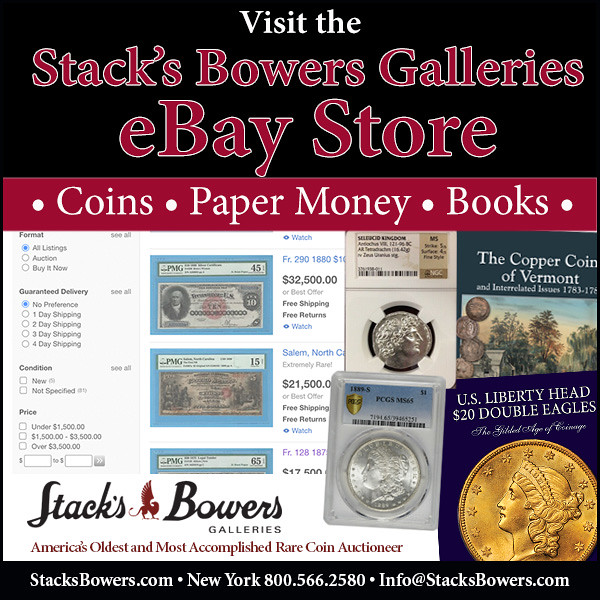
THE HISTORY OF THE FREEDMAN'S BANK
A publication of the University of Chicago Booth School of Business looks at the history of The Freedman's Bank -Editor
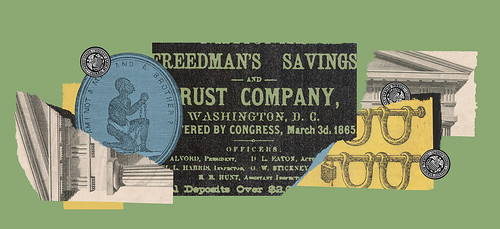
Some of the research into the Freedman's Bank stems from a visit by Chicago Booth's Constantine Yannelis to the US Treasury in fall 2018. Due to a temporary security issue, the main entrance was closed, and Yannelis was routed to exit the building via an annex that two years earlier had been renamed "The Freedman's Bank Building." Having never heard of the bank, Yannelis looked it up.
The first Freedman's Bank opened on April 4, 1865. As University of California at Irvine's Mehrsa Baradaran explains in her 2017 book The Color of Money: Black Banks and the Racial Wealth Gap, the government originally proposed distributing land to people who had been enslaved, but faced a violent backlash from Southern whites. "Instead of land, freed slaves got rights that they could not use due to their economic and political status at the bottom rung of society. They also got a savings bank, which was another form of diversion that would be repeated in the next century," Baradaran writes.
Black Americans still opened accounts with the Freedman's Bank at a "phenomenal" rate, according to the US National Archives and Records Administration. Customers, almost entirely newly freed Black Americans, could open an account with as little as 5 cents, and interest was paid on deposits of $1 or more. Most deposits were small, less than $60 on average. More than 100,000 people became customers—farmers, cooks, barbers, nurses, carpenters—many of them likely taking home their first paychecks.
Stein and Yannelis analyzed surviving account-register records that had been microfilmed by the National Archives and later digitized in CD-ROM format by FamilySearch, a nonprofit genealogy association, obtaining data from 107,197 accounts across 27 Freedman's Bank branches, totaling 483,082 nonunique individuals—roughly 12 percent of the 1870 Black population in the American South. They lined these records up with a sample from the 1870 census containing information on schooling, literacy, employment, and wealth among Black Americans. (Literacy data was collected by the Census Bureau at the time.)
The Freedman's Bank, they determine, had a small but significant impact on the economic well-being and outlook of its account holders. An initial regression analysis finds that individuals in households with an account at the bank were 1 percentage point more likely to be literate and to attend schools. The same individuals were 2 percentage points more likely to work and to have higher incomes than their peers.
Being able to bank raised incomes, literacy levels, and landownership through one or more channels, according to the research. Among these, having an account may have allowed individuals to save to make large purchases, such as a plot of land; to invest in workers; or to open a business. It also may have helped them overcome challenges associated with irregular income and shocks, which were often tied to fickle agricultural harvests, by providing a place to make consistent, recurring payments and save up a cash cushion. (Costs associated with withdrawals may have discouraged depositors from taking out money unless necessary, which encouraged saving.)
Southern Democrats were generally hostile to the bank, its customers, and its supporters. Meanwhile, Republicans, who had set up the bank, were overall more supportive of programs such as schools and economic development.
The access to financial services that the Freedman's Bank was able to offer to an unbanked population had real impact at the Black American individual and household level, they argue, and this impact extended to the community in terms of its ability to accelerate education and wealth accumulation. An average county near an early bank branch had about 10,700 Black residents and 2,700 account holders, and the analysis suggests financial inclusion boosted school attendance rates by up to 5 percentage points and literacy by up to 18 percentage points, with positive effects on income, employment, and business ownership.
The Freedman's Bank was not to last, however. Although set up as an institution strictly dedicated to savings, the bank was soon investing its depositors' hard-earned savings into risky railroad companies and real estate. Its coffers were largely co-opted by the First National Bank, which offloaded its liabilities onto the Freedman's Bank books with no objection from the latter's all-white trustees.
The Panic of 1873 was a death knell, as real-estate prices fell, loans went bad, and depositors demanded their money back. Social reformer, author, lecturer, and statesman Frederick Douglass was elected the bank's president in a bid to save it, but he quickly became aware of the bank's dire conditions and turned to Congress. On June 29, 1874, the bank's trustees voted to shutter it and left more than 60,000 depositors with nearly $3 million in losses. Federal deposit insurance did not yet exist, and while there was some compensation for customers, the fight to make depositors whole continued in Congress for decades, into the 20th century, to no avail. The Freedman's Bank headquarters was torn down in 1899, replaced in 1919 by what would become the Treasury annex.
To read the complete article, see:
How powerful is financial inclusion?
(https://review.chicagobooth.edu/economics/2020/article/how-powerful-financial-inclusion)
It's a sad and disappointing history for what could have been an important financial institution well into the 20th century or beyond. See John Kraljevich's article on NNP (the last of those linked below) for more. -Editor
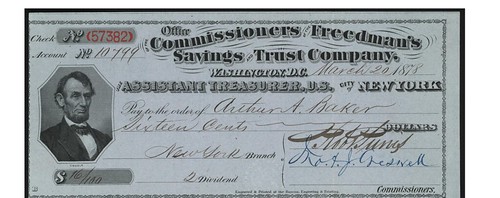
For more information, see:
The Freedman's Savings Bank: Good Intentions Were Not Enough; A Noble Experiment Goes Awry
(https://www.occ.treas.gov/about/who-we-are/history/1863-1865/1863-1865-freedmans-savings-bank.html)
http://freedmansbank.org/
The Freedman's Bank
(https://nnp.wustl.edu/blog-post/515967)
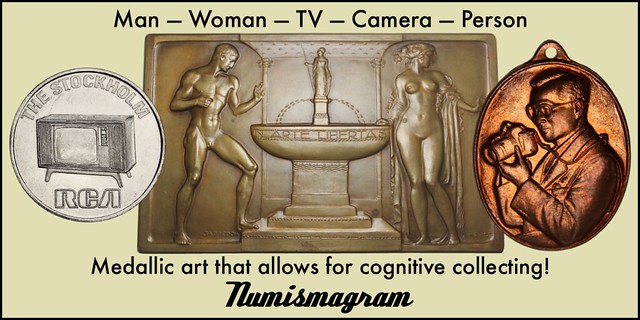
VOCABULARY TERMS: MOLD, MOLDING
Dick Johnson submitted this entry from his Encyclopedia of Coin and Medal Terminology. Thanks. Elsewhere in this issue is an article on this topic at Colonial Williamsburg. -Editor
Mold, Molding. The matrix containing the cavities to form a cast piece, and the process of producing that piece. The material to form the casting must be molten, the mold must be capable of sustaining heat and holding the form until the molten material solidifies. There are several kinds of molds, they differ in what they are made of and what they produce. Also molds can be used for only a single cast, these differ from production run casting, where a permanent mold is made often of two or more metal parts for repeated use. The use of molds for medallic production is rather limited, many types of molds have little concern to this field.
Types of molds. Molds can be made of a variety of material – called the investment – these can be metal, ceramic, rubber, plaster, epoxy, gelatin, silicone, and, or other. Since numismatic items are concerned with sharp, fine, minute detail, several of these investments, like sand, are not suitable for casting of numismatic or medallic items.
Lost wax, (cire-perdue) is a waste wax or waste mold type and is suitable for medallic castings. flexible mold, made of gelatin, rubber or silicon are suitable for casts with undercuts; ideal for medallic plaques. Others – like piece mold – which are used for sculpture in the round – have no application in the numismatic field.
The pattern from which the mold is made can be a variety of materials. Often it is wax, plaster, or wood. Some wood patterns for coins were made in Germany in the 15th century. England made coin patterns of iron, these were cast for use on early die-cutting pantographs (which more typically would use an electroform copper pattern.)
Molds were used for the cash coins of China for centuries. These formed cash "trees" with sprues still intact from which coins were broken off. Several of these molds still exist in museums today.
See also foundry cast.
Looking for the meaning of a numismatic word, or the description of a term? Try the Newman Numismatic Portal's Numismatic Dictionary at: https://nnp.wustl.edu/library/dictionary
Or if you would like a printed copy of the complete Encyclopedia, it is available. There are 1,854 terms, on 678 pages, in The Encyclopedia of Coin and Medal Technology. Even running two a week would require more than 19 years to publish them all. If you would like an advance draft of this vital reference work it may be obtained from the author for your check of $50 sent postpaid. Dick Johnson, 139 Thompson Drive, Torrington, CT 06790.
RIGHT REVEREND EDMOND MARIE OBRECHT (1852-1935)
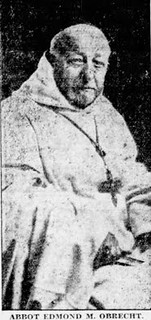 Right Reverend Edmond Marie Obrecht (1852-1935), was born on November 13, 1852, Stotsheim, Bas Rhin, Department of France, (now Alsace), son of Nicholas Obrecht (1829-1842), and Auguste Dorothea Sophie Matthies (1826-).
Right Reverend Edmond Marie Obrecht (1852-1935), was born on November 13, 1852, Stotsheim, Bas Rhin, Department of France, (now Alsace), son of Nicholas Obrecht (1829-1842), and Auguste Dorothea Sophie Matthies (1826-).
From 1869-1870, he served in the French army during the Franco-Prussian War.
In 1871, he studied for the priesthood in the Seminary at Sees, France.
In 1876, he made his final vows at the Monastery of the Three Fountains, Rome.
In 1879, he was ordained a priest.
In 1880, he was named Vice-Procurator General in his first year.
In the 1890's he arrived at the Abbey in New York.
In 1898, he was abbot of Our Lady of Gethsemane Abbey, New Hope, Nelson, Kentucky, which had sixty-six monks under his care.
He directed all the improvements to the Abbey and created the library and museum.
He had amassed one of the most valuable stamp collections in the United States. According to Herman Herst, Jr., Nassau Street, page 148 "The albums were housed between massive hand-carved covers; the pages were hand drawn." Also, according to Herman Herst, Jr., the collection was purchased by the Pittsburgh stamp dealer, Dr. Pritchard Von David. Von David, a few years later became a member of the board of directors of New England Stamp Company, a subsidiary of Scott Stamp and Coin, Ltd., since 1901.
He was the personal friend of four Popes : Leo XIII, Pius X, Benedict XV, and Pius XI.
He died on January 4, 1935, at Nelson, Kentucky, U. S. A.
To read the complete article, see:
OBRECHT, RT. REV. EDMOND MARIE
(http://www.numismaticmall.com/numismaticmall-com/obrecht-rt-rev-edmond-marie)
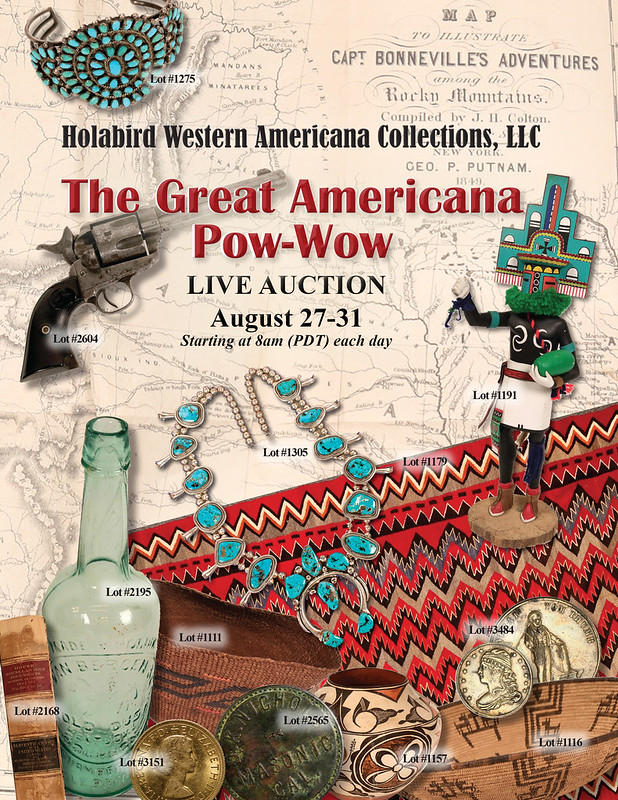
GEORGE BUSH COIN DESIGNER ELANA HAGLER
An Alabama State University assistant professor designed the new George H.W. Bush Presidential dollar coin. -Editor
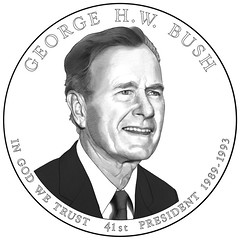 An assistant professor at Alabama State University can now add ‘coin designer' to her list of accolades! Elana Hagler's design for the George H.W. Bush Presidential $1 coin was recently selected by the United States Mint.
An assistant professor at Alabama State University can now add ‘coin designer' to her list of accolades! Elana Hagler's design for the George H.W. Bush Presidential $1 coin was recently selected by the United States Mint.
The coin features the late president's smiling portrait with the inscriptions "George H.W. Bush" above his head and "In God We Trust," "41st President," and "1989-1993" at the bottom.
On the reverse side of the coin, a rendition of the Statue of Liberty is featured.
"Well, when I found out that I got put on the Bush project specifically, I was very excited," Hagler said, "because I love portraiture, it's my favorite thing."
Hagler is an immigrant from Israel to the United States and said getting to work on a project involving a U.S. president "obviously is a big honor."
"I was 5-years-old when I came to this country. So that, for me, makes it all the more special to get to work on the portrait," she explained.
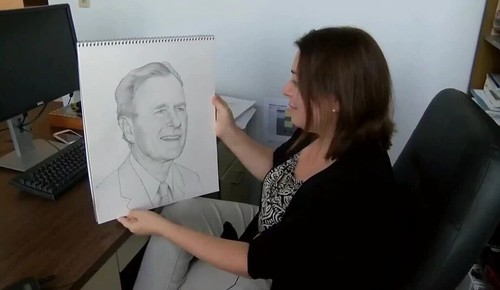
Hagler first learned of the competition in 2018 and several people recommended she enter. She said at first she didn't consider it but later changed her mind and pulled together an entry based on many different photos and recollections she has of the man.
Hagler has been painting since she was a child and got more serious with it around age 20 when she switched her major from neuroscience psychology to fine arts.
To read the complete article, see:
ASU professor designs new presidential coin for U.S. Mint
(https://www.wtvy.com/2020/08/19/asu-professor-designs-new-presidential-coin-for-us-mint/)
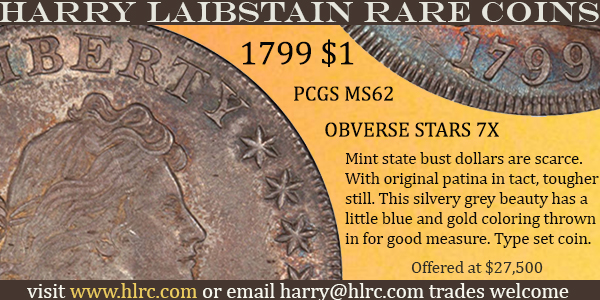
ANCIENT COINS IN EARLY AMERICAN AUCTIONS
We have a number of ancient coin sales coming up. Readers might be interested in David Fanning's upcoming talk at the Newman Numismatic Portal Symposium on Ancient Coins in Early American Auctions. It's on Saturday, August 29 at 10:00AM EDT. -Editor

To register for the NNP Symposium, see:
NNP Symposium 2020 by EPNNES & NNP
(https://www.eventbrite.com/e/nnp-symposium-2020-registration-107734855854)
DAVISSON'S E-AUCTION 36 ANCIENTS
Marnie & Lief Davisson reviewed some of the ancient coins in their upcoming E-Auction 36 in an email to clients this week. Here's an excerpt. -Editor
Our Ancient Greek section includes lots from a broad span–Spain, Italy, Sicily, Greece, Asia Minor–a few particularly special pieces are below:
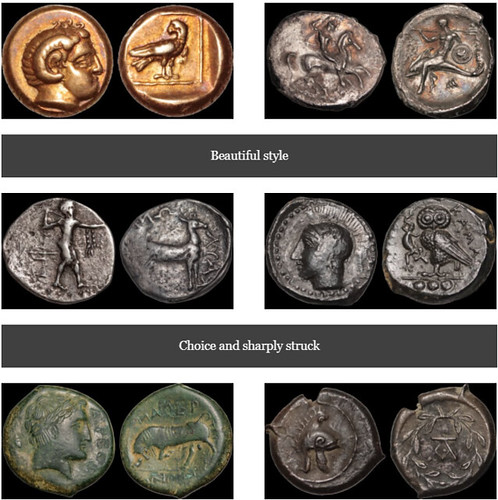
Lots 21 and 24 are of particular interest. The tyrants of Sicily had always employed mercenaries, often hired in Campania and Central Italy. In a land famed for its sweeping landscapes–ideal for the breeding of strong horses–the emergent Campanian nobility developed their renowned cavalry. Carrying heavy javelins for skirmishing and swords for melee, they used speed, agility, and flexibility of tactics to inflict damage on more heavily armed, and therefore slower moving, opponents. When King Agathocles of Syracuse died many of his strong young mercenaries refused to leave Sicily, and captured the Greek city of Messana in circa 288 B.C. They adopted the name of their war god Mamers, Oscan for Mars, often fighting like pirates and plundering the neighboring districts. Their activities which finally engaged the Romans against the Carthaginians set off the First Punic War (264-241 B.C.).
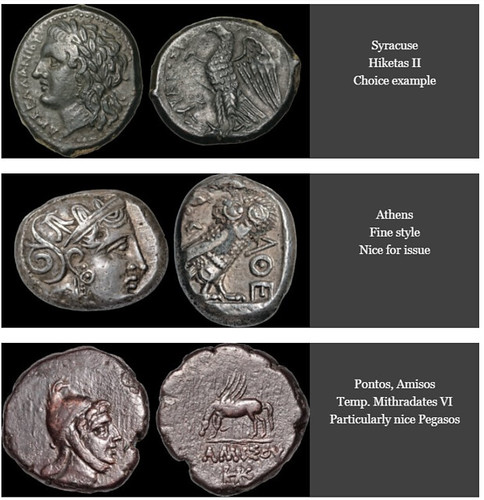
For more information, or to bid, see:
https://davcoin.com/
To read the earlier E-Sylum article, see:
DAVISSONS ANNOUNCES E-AUCTION 36
(https://www.coinbooks.org/v23/esylum_v23n31a21.html)

ROBINSON ANCIENT COIN SALE 113 SELECTIONS
Here are a few items that caught my eye in Frank Robinson's Auction 113 closing September 1. 2020. Note that there is no buyer's fee. -Editor
Lot 1: ABDERA, Tetrobol
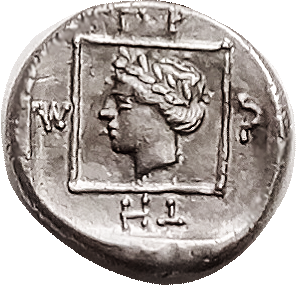
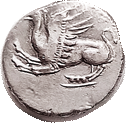
ABDERA, Tetrobol, 415-395 BC, Griffin springing left/ Dionysos head l in square, Magistrate Protes, sim S1549 (£200); EF, obv sl off-ctr crowding Griffin's head, rev nrly centered & complete, head quite sharp; good metal with lt tone. (A GVF of the type, brought $1034, Roma 2/14.) Starting Bid $250
Unusual boxed portrait. -Editor
Lot 5: AMISOS Athena head
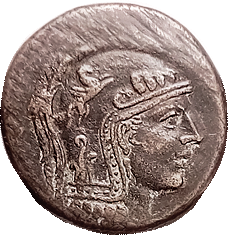
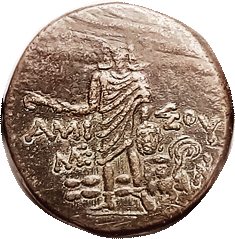
AMISOS, Æ29, c.100 BC, Athena head r/Perseus stg hldg severed head of Medusa, her body at his feet spouting blood; ME monogram, S3637; VF+, centered just sl low, medium brown patina, basically smooth tho with some lt planchet adjustment at tops; Perseus's head wk, otherwise unusually strong detail, even Medusa's face quite clear. My note on env says "selected as best overall from sizeable hoard" (1991). One of my favorite types due to the graphic rev scene!
(Far better than a Near VF (diff monogram) bringing $437, CNG eAuc 3/15.) Starting Bid $135
Nice coin - one I hadn't seen before. -Editor
Lot 21: CARIAN Satraps, Pixodaros, Didrachm
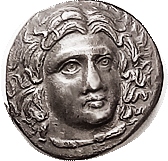
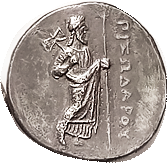
CARIAN Satraps, Pixodaros, 341-335 BC, Didrachm, Apollo head 3/4 rt/Zeus Labraundos stg r, S4966; VF-EF, centered, well struck, good strong head in high relief & fine style. Possible traces of rev smoothing but good metal with medium dark tone. Quite attractive. (A granular GVF brought $748, Gemini 1/07.) Starting Bid $350
Great relief. -Editor
Lot 73: MASIKYTES Lycian League Hemidrachm
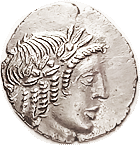
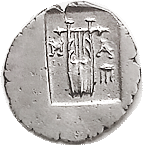
MASIKYTES, Lycian League Hemidrachm, c. 27-20 BC, Apollo head r/M-A, Lyre, tripod, in incuse square; EF, somewhat off-ctr but nothing lost, good bright silver, well struck with wonderful detail on head. (A Near EF, same variety, realized $358, CNG eAuc 10/11.) Starting Bid $190
Nice portrait. -Editor
Lot 154: THOURIOI Tetradrachm
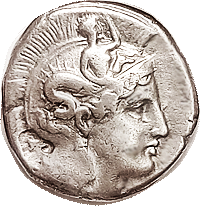
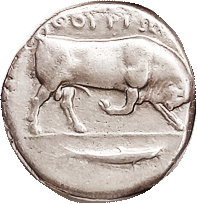
THOURIOI, Distater or Tetradrachm, 400-350 BC, Athena hd r, Skylla on helmet/bull butting r, fish in exergue; S440 (£700); VF, good bright metal, quite good centering for this with full helmet crest & bull complete.
Rare & desirable thus. (A GVF, "somewhat lightly struck" brought $2677, Nomos 5/16.) Starting bid $650
Love the bull! Almost Art Deco. -Editor
For more information, see:
http://www.fsrcoin.com/
To read the earlier E-Sylum article, see:
ROBINSON ANCIENT COIN SALE 113 ANNOUNCED
(https://www.coinbooks.org/v23/esylum_v23n31a19.html)

CLASSICAL NUMISMATIC GROUP SALE 115 ANNOUNCED
For even more ancient coins to consider, here's the press release for the CNG fall sale closing September 16-17, 2020. Some great coins here. -Editor
A Live Online Sale
Closing Wednesday & Thursday, 16-17 September 2020
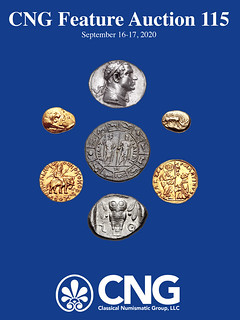 Classical Numismatic Group, LLC is proud to present CNG Feature Auction 115, a Live Online Sale closing Wednesday & Thursday, 16-17 September 2020, from our Lancaster, Pennsylvania office. This sale offers 1235 lots with a presale estimate of $1.83 million.
Classical Numismatic Group, LLC is proud to present CNG Feature Auction 115, a Live Online Sale closing Wednesday & Thursday, 16-17 September 2020, from our Lancaster, Pennsylvania office. This sale offers 1235 lots with a presale estimate of $1.83 million.
Our annual fall sale features Greek, Celtic, Oriental Greek, Central Asian, Roman Provincial, Roman Republican and Imperatorial, Roman Imperial coinage, and Romano-Byzantine Weights. Additionally, there are featured selections of Byzantine, Early Medieval and Islamic, World coinage and medals, British coinage and medals, Electrotypes & Reproductions, and Antiquities.
CNG 115 is highlighted by a number of collections and individual rarities, which make up the majority of coins on offer:
• A Diverse Offering of Coins from the El Medina Collection
• Ancient Coins from the Batory, James Barry, Toliver Besson, Grand Haven, Jonathan P. Rosen, & Weise Collections
• Syracuse Dekadrachms of the Masters Kimon and Euainetos
• Further Selections of Electrum of Kyzikos from the Siren Collection
• Seleukid Rarities from the MNL Collection
• Extremely Rare Tetradrachm of Pantaleon Soter
• Alexandrian Coins from the Rocky Mountain and Stein A. Evensen Collections
• The Enigmatic Crawford 482/1 Denarius of Octavian
• An Exceptional "Eyes to God" Solidus of Constantine I
• Byzantine Coins from the Simon Bendall Collection and the Gasvoda Duplicates
• Knights of Malta Coinage from the El Medina Collection
• British Coins from the Todd Hansen, Maxwell, and James & Martha Robertson Collections
• The Finest Known Sceatt of Eardwulf
• A Pleasing Anglo-Viking St. Peter Sword-and-Hammer Penny
Catalogs for CNG 115 have been mailed to our active mailing list and bidding is open on the site. Some of the individual highlights from CNG 115 are:
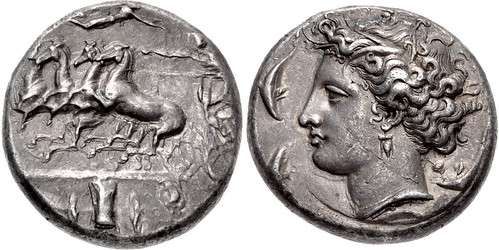
Lot 56–SICILY, Syracuse. Dionysios I. 405-367 BC. AR Dekadrachm (32mm, 43.34 g, 2h). Unsigned dies in the style of Euainetos. Struck circa 405-380/67 BC. Charioteer, holding kentron in extended right hand and reins in left, driving fast quadriga left; above, Nike flying right, crowning charioteer with wreath held in her extended hands; below heavy exergual line, [military harness, shield], greaves, cuirass, and crested Attic helmet, all connected by a horizontal spear; [AT?A below] / Head of Arethousa left, wearing wreath of grain ears, triple-pendant earring, and pearl necklace; S?-??-[?-?-S?O?] above, scallop shell behind neck, four dolphins swimming around. Gallatin dies R.XVIII/F.VIII; Scavino 53 (D16/R27); HGC 2, 1299; SNG Copenhagen 693 (same dies); SNG Fitzwilliam 1279 (same rev. die); SNG Lockett 991 (same rev. die); de Luynes 1247 (same rev. die). Toned, compact flan, minor die shift, flan flaws on reverse. NGC photo certified. Lot includes an NGC Photo Certificate, 4684186-001, grading the coin Ch XF, Strike: 4/5, Surface: 4/5, Fine Style, die shift. Estimated at $25,000
From the Grand Haven Collection. Ex Pegasi X (5 May 2004), lot 96.
The engraver Euainetos seems to have begun his series of signed dekadrachm dies a few years after Kimon; perhaps he began as an apprentice and "graduated" to master status. His dekadrachm design superseded that of Kimon and became a paradigm for coinage throughout the classical world. His Arethousa is less human and more divine than his predecessor's vision. The wreath of grain ears woven into her hair symbolizes the agricultural bounty of Sicily. His racing chariot is the essence of action, almost photographically frozen in time, with the charging, rearing horses appearing to levitate above the ground line. The design was widely copied on later coinage of Syracuse, as well as by the Carthaginian forces in Sicily.
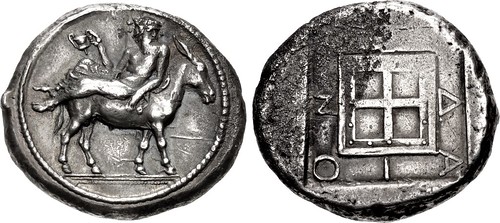
Lot 95–MACEDON, Mende. Circa 460-423 BC. AR Tetradrachm (26mm, 17.00 g, 12h). Inebriated Dionysos, wearing chiton draped from his waist, holding in right hand a kantharos propped on his right knee, reclining left, head right, on the back of an ass standing right / [MEN]-?A-I-ON within shallow incuse around quadripartite square in linear border ornamented with dots; all within incuse square. Noe, Mende 83 (this coin referenced); HGC 3, 548 (this coin illustrated); SNG ANS 345 (same dies); SNG Lockett 1352 (this coin); Jameson 1969 (same dies); Kraay & Hirmer 405 = GPCG pl. 10, 14; ACGC 462 = SNG Ashmolean 2303 (same dies). Old collection tone, area of light granularity, small area of flat strike on reverse. Good VF. Fine style. Estimated at $15,000
Ex Classical Numismatic Group 88 (14 September 2011), lot 85; Leu 20 (25 April 1978), lot 66; Munzen & Medaillen AG XXV (17 November 1962), lot 435; Richard Cyril Lockett Collection (Part VI [Greek Part II], Glendining, 12 February 1958), lot 1273; G. Empedocles Collection; 1913 Kaliandra Hoard (IGCH 358).
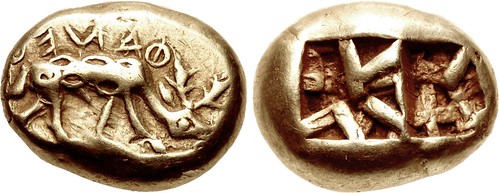
Lot 215–IONIA, Ephesos. Phanes. Circa 625-600 BC. EL Trite – Third Stater (14mm, 4.71 g). Stag grazing right, its dappled coat indicated by indentations on the body; FANEO[S] (retrograde) above / Two incuse squares flanking central incuse rectangle, each with raised intersecting lines within. Fischer-Bossert, Phanes 11b (O8/R20S&20L – this coin); Weidauer 40; SNG München 14; ACGC 54; GPCG p. 98, 3 = Kraay & Hirmer 585; Zhuyuetang 8. Lightly toned. Good VF. Well struck with a particularly clear inscription and stag. Very rare, with fewer than twenty trites of Phanes known. Estimated at $30,000
From the M.J.W. Collection. Ex Berk BBS 159 (28 April 2008), lot 1.
The celebrated coins of Phanes – the first coins on which a legend appears – are known to be among the earliest of Greek coins, as a hemihekte (twelfth stater) of the issue was found in the famous foundation deposit of the temple of Artemis at Ephesos, built circa 550 BC. It is this find spot, along with the design of the grazing stag, that suggests Ephesos as the mint. If indeed a person, the mysterious "Phanes" named on this piece was likely an Ephesian treasury minister or a private individual wealthy enough to strike his own coinage. An alternative reading of the legend as "Phaneos" (light-bringer) has also been proposed, perhaps referring to an aspect of Artemis or her brother, Apollo.
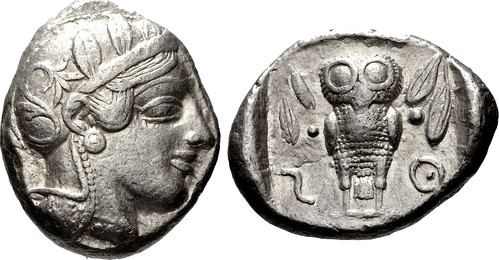
Lot 350–PHILISTIA (PALESTINE), Gaza (‘Azah) Mid 5th century-333 BC. AR Tetradrachm (21mm, 17.43 g, 9h). Imitating Athens. Head of Athena right, with frontal eye, wearing earring, necklace with pendants, and crested Attic helmet decorated with three olive leaves over visor and a spiral palmette on the bowl / Owl standing facing, wings folded; olive sprigs in upper corners, ‘AZ (in Phoenician) across lower field; all within incuse square. Gitler & Tal V.5Ta = SNG ANS 1 = SNG Berry 701 = Van Alfen, Two, p. 65, 9 = Mildenberg, Gaza, pl. 4, 1 (same dies); HGC 10, 532 (same dies as illustration); BMC Palestine pl. 42, 1 = Mildenberg, Money, pl. 1, 5 (same obv. die); Boston MFA 2203 = ACGC 207 = Svoronos, Monnaies pl. 110, 49 (same obv. die); Heritage 3075, lot 32034 (same dies); Künker 280, lot 264 (same dies); NAC 64, lot 1528 (same dies); Triton XXII, lot 388 (same obv. die). Slight die wear, minor marks, slight weakness at center of reverse. VF. Extremely rare. Apparently the eighth known, with only five examples recorded, three of which are in museum collections (ANS, Boston, and Berlin [the latter illustrated in Mildenberg, Money, and BMC]). Estimated at $10,000
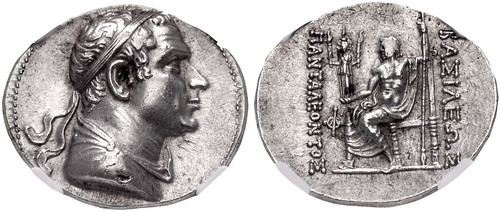
Lot 398–BAKTRIA, Greco-Baktrian Kingdom. Pantaleon Soter. Circa 185-180 BC. AR Tetradrachm (31mm, 16.88 g, 11h). Diademed and draped bust right / BASI?EOS to right, ?ANTA?EONTOS to left, Zeus enthroned left, holding in right hand statue of Hekate, who holds torch in each hand, and scepter; monogram to inner left. Bopearachchi 1A = MIG Type 157a = HGC 12, 100 (same dies as illustration); Bopearachchi & Rahman 168 (same obv. die); SNG ANS –; Zeno –; NAC 77, lot 107 (same dies). In NGC encapsulation 5768164-002, graded Ch AU?, Strike: 4/5, Surface: 4/5, Fine Style. With an attractive, high-relief portrait. Extremely rare and among the finest known. Estimated at $50,000
Known only from his coins, the identity of this Greco-Bactrian king has long been a subject of debate. Some nineteenth century scholars, who were working with a more limited selection of coins, believed that Pantaleon, along with Agathokles, was a son of Diodotos I. But as more numismatic evidence came to light, it was clear that kings such as Agathokles, Antimachos, and Pantaleon could not be part of the Diodotids who ruled in the early period of Baktrian independence from the Seleukids.
The coinages of Pantaleon and Agathokles are similar in many respects, leading some authorities to suspect that they were relatives. The portrait on this tetradrachm, for example, is closely linked to those of Agathokles, suggesting there was an effort to demonstrate unity or solidarity. Pantaleon's well-modeled image is somewhat older and heavier than that of Agathokles, and has a less pronounced chin.
A further indication that Pantaleon and Agathokles were closely associated is the fact that Agathokles struck pedigree tetradrachms for Pantaleon (as savior). This would suggest that Pantaleon was either a predecessor or a contemporary who died before Agathokles, whose coinage demonstrates that his reign was significantly longer than that of Pantaleon.
The five examples of this issue are known from one obverse and three reverse dies:
1. A/a
a. London, British Museum, inv. 1888,1208.108 [Bopearachchi 1A(illustration); MIG Type 157a; HGC 12, 100]
b. NAC 77, lot 107
c. CNG 115, lot 390 (the present example)
2. A/b
a. Triton I, lot 594
3. A/c
a. Bopearachchi & Rahman 168
Enigmatic Crawford 482/1
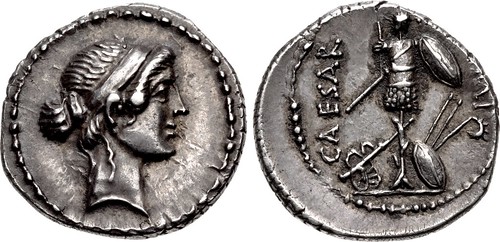
Lot 606–The Triumvirs. Octavian. Spring 43 BC. AR Denarius (18mm, 3.62 g, 12h). Military mint traveling with Octavian in Italy or Cisalpine Gaul. Head of Venus (with features of Apollo) right, wearing fillet, her hair collected into a knot behind / Trophy of Gallic arms, chariot at base on left, a shield, two spears and carnyx on right; CAESAR upward on left, [I]MP downward on right. Crawford 482/1; CRI 130; Sydenham 1016; RSC 15 (Caesar); RBW 1696. Lovely old cabinet toning, reverse struck slightly off center with some deposits in the devices. EF. Very rare and among the finest known. Estimated at $30,000
Ex Gemini V (6 January 2009), lot 783; Naville X (15 June 1925), lot 1737.
Considered by Crawford as the last denarius minted by Julius Caesar, David Sear considers it the first military issue of Octavian. For further discussion on this enigmatic type, see the commentary by Andrew McCabe for his specimen that we sold in CNG E-Auction 432 (November 2018), lot 271.
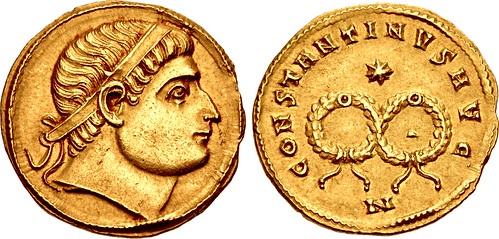
Lot 719–Constantine I. AD 307/310-337. AV Solidus (19mm, 4.50 g, 6h). Nicomedia mint. Struck AD 326. Head right, wearing plain diadem, eyes to God / CONSTANTINVS AVG, two interlaced wreaths; star above; N. RIC VII 109; Alföldi 41; Depeyrot 38/2; Biaggi –; Mazzini –. A few faint scratches and marks, tiny obverse die break. EF. Very rare. Exceptional portrait. Estimated at $15,000
Ex Numismatica Ars Classica 102 (24 October 2017), lot 582 (24,000 CHF); Roma I (15 October 2010), lot 517; Hess-Leu 36 (17 April 1968), lot 556.
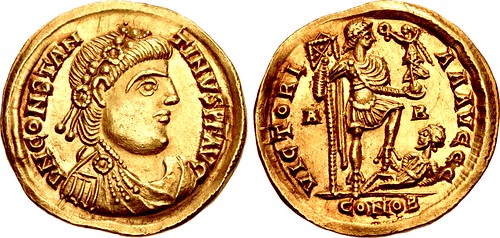
Lot 744–Constantine III. AD 407-411. AV Solidus (21.5mm, 4.44 g, 6h). Arelate (Arles) mint. D N CONSTAN TINVS P F AVG, rosette-diademed, draped, and cuirassed bust right / VICTORI A AAVGGG, Constantine III, laureate and in military attire, standing right, holding vexillum in right hand and Victory on globe in left hand, with his left foot he treads down a seated captive; A|R//CONOB. RIC X 1519; Ferrando p. 343, 1701 (this coin illustrated); Depeyrot –; Biaggi –. Lustrous, traces of earthen deposits. EF. Very rare. Estimated at $15,000
Ex Numismatica Ars Classica 52 (7 October 2009), lot 653 (hammer 18,000 CHF); Property of an European Nobleman (Numismatica Ars Classica 24, 5 December 2002), lot 334; Superior (11 December 1992), lot 2553; Clarence S. Bement Collection (Ars Classica VIII, 25 June 1924), lot 1581.
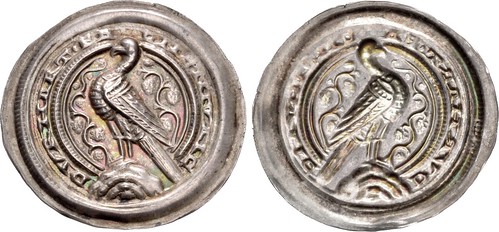
Lot 861–GERMANY, Falkenstein (Grafschaft). Burkhard II. 1142-1174. AR Bracteate (29mm, 0.81 g). Ermsleben mint. DVRH?RT • F? • • LNSNIV?C, eagle standing left on rock / Incuse of obverse. Kestner 1445; Bonhoff –; Löbbecke 231. Wonderful cabinet toning. Choice EF. Very rare. Estimated at $10,000
From the Dr. William J. Conte Collection of Bracteates. Ex Dr. Helmut Hahn Collection (Künker 301, 1 February 2018), lot 545.
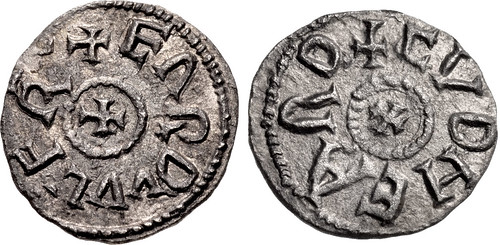
Lot 1005–ANGLO-SAXON, Kings of Northumbria. Eardwulf. First reign, 796-806. AR Sceatt (13mm, 0.99 g, 3h). York mint; Cuthheard, moneyer. + E?RDVVL·F R, cross pattée in dotted circle / + CVDHEARD, cross pattée in dotted circle. Pirie, Guide 3.2a var. = E.J.E. Pirie, "Earduulf: a significant addition to the coinage of Northumbria" in BNJ 65 (1995), pl. 2, 12 var. (no circle on rev.; same obv. die as illustration); Sceatta List 86-10 (same dies as illustration); North –; SCBC 858. Near EF. Struck on a full flan in unusually good metal. The finest known example of this great Northumbrian rarity. Estimated at $10,000
Eardwulf acceded to the Northumbrian throne in the tumultuous period following the assassination of Aethelred I in 796. Eardwulf had helped organize the murder of Aethelred in revenge for Aethelred's earlier, nearly successful, attempt on Eardwulf's life. Eardwulf's reign was characterized by conflict with Coenwulf of Mercia who gave asylum to his enemies. In the late eighth century, close ties existed between the Northumbrian and Frankish courts and it may have been that Eardwulf married an illegitimate daughter of Charlemagne. Eardwulf was deposed in 806 by the shadowy Aelfwald II and went on pilgrimage to Rome and visited the Emperor's court in Nijmegen. Frankish sources suggest he may have reclaimed his kingdom in circa 808 before being succeeded by his son Eanred, possibly around 810. No coins were known of Eardwulf before the Burton Fleming find in 1994 (EMC 1995.6001; Pirie, BNJ 1995, pp. 20-31). This is the only second coin of Eardwulf to be offered for sale in a public auction (the first was in CNG 114, lot 1245 [hammer $9500]).
Printed catalogs for CNG 115 are now available. To order the catalog, please call our U.S. office at (717) 390-9194. Catalogs have been mailed to customers on CNG's active mailing list. Prospective bidders may also view the virtual catalogs at https://issuu.com/cngcoins/docs/cng_115_virtual_catalog. The sale can be viewed online at auctions.cngcoins.com, sixbid.com, and numisbids.com.
In addition to CNG Feature Auction 115, CNG will also feature over 900 lots from many of the same collections listed above in their Electronic Auction 477, closing one week later on Wednesday, 23 September 2020, from 10AM ET (U.S.). Bidding for CNG Electronic Auction 477 will begin on 9 September 2020.
CNG is currently accepting consignments for future auctions sales. Please contact the firm for further details and consignment deadlines.
For further details and any additional information, please contact CNG, LLC at:
Classical Numismatic Group, LLC
P.O. Box 479
Lancaster, PA 17608-0479
Telephone: (717) 390-9194
Fax: (717) 390-9978
Email:
cng@cngcoins.com

MORE HOLABIRD AUGUST 2020 SALE SELECTIONS
Here are some additional items that caught my eye in the upcoming August 2020 Great Americana Pow-Wow Auction from Holabird Americana. -Editor
Lot 3260: Carnival & Peace Jubilee So Called Dime (121370)
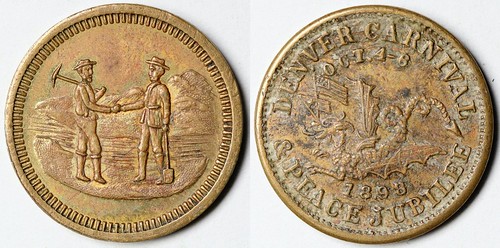
Obv.: Denver Carnival / Oct. 4-6 / 1898 / & Peace Jubilee; Rev.: pictorial two miners. Br., rd., 18 mm.
Date: 1898
State: Colorado
City: Denver
Provenance: Benjamin Fauver Collection
See the article by Paul Williams elsewhere in this issue about the "So-Called Dimes" in the Fauver collection. -Editor
To read the complete lot description, see:
Carnival & Peace Jubilee So Called Dime (121370)
(https://holabirdamericana.liveauctiongroup.com/Carnival-Peace-Jubilee-So-Called-Dime-121370_i38149288)
Lot 3243: Antebellum Letter to the San Francisco Mint
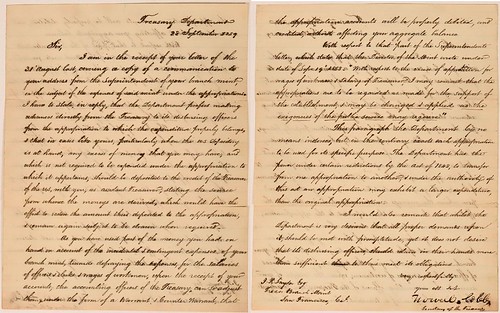
Two pp. letter sent September 28, 1859 from Howell Cobb, Secretary of the Treasury, to Snyder, Treasurer of the San Francisco Mint. Howell Cobb was a five-term member of the United States House of Representatives and Speaker of the House from 1849 to 1851; he also served as the 40th Governor of Georgia (1851–1853) and as a Secretary of the Treasury under President James Buchanan (1857–1860), the job he is writing this letter while working. He is probably best known as one of the founders of the Confederacy, having served as the President of the Provisional Congress of the Confederate States. William T. Sherman called him "one of the leading rebels of the South." Letter refers to an inquiry from the mint superintendent about expenses of the mint under appropriations. In Cobb's response, he seems to be cautioning the treasurer about how money has been used to pay wages for the officers and workmen. Just a year later, Cobb would join the secession movement. 7.5 x 9.5" Folds with a few tears.
Provenance: Fred Holabird Collection
Interesting item; great for a Civil War collection as well as U.S. Mint. -Editor
To read the complete lot description, see:
1859 Letter to SF Mint from Howell Cobb (Founder of the Confederacy) (113621)
(https://holabirdamericana.liveauctiongroup.com/1859-Letter-to-SF-Mint-from-Howell-Cobb-Founder-of-the-Confederacy-113621_i38149271)
Lot 3245: San Francisco Mint Employment Correspondence
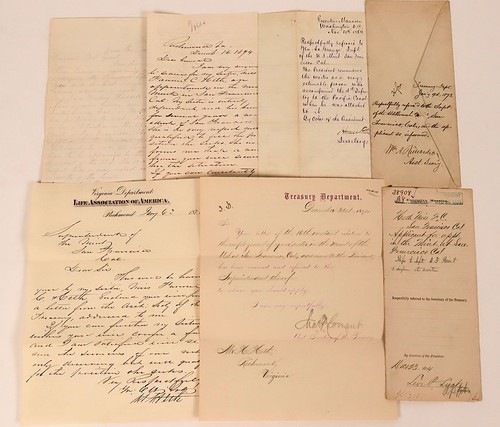
Lot of 7. US Grant served from 1869-1877. 1) Dec. 1872 letter addressed to President US Grant. Letter from Martha G. Grant (no relation?) discusses her niece Jane Hudson Waddell, living in Santa Cruz, who would like to work for the San Francisco Mint. She asked the director there but he said she would need appointment by the president. Comes with Executive Mansion cover that has hand-written message to Treasury Dept., Jan. 9th, 1873, recommending applicant. 2) 1869 letter written from Lydia Gardner of San Francisco, addressed to "Mr. President." Message reminds President Grant that he knows her from the 4th Infantry. Her husband has died, and she has heard "There is a number of women who perhaps have not the claim that a soldiers daughter has employed in the Branch Mint...and I would like to be employed there." Back of letter had message written from the Executive Mansion by a secretary referring Lydia Gardner to General La Grange. "The president remembers the writer as a very estimable person who accompanied the 4th Infantry to the Pacific Coast when he was attached to it." 3) Three pieces of correspondence and a cover. December 1864 letter from Heth asking for a job for his sister, Fannie. Addressed to "General." Dec. 1864 letter from Treasury Department acknowledging the letter had been received and referred to the Mint Supt. Finally, a Jan. 1865 letter from Heth to the Supt. of the SF Mint about the previous letters and recommendation from the President.
Provenance: Fred Holabird Collection
More great Mint-related correspondence. -Editor
To read the complete lot description, see:
San Francisco Mint-Related Correspondence to President Ulysses S. Grant (113619)
(https://holabirdamericana.liveauctiongroup.com/San-Francisco-Mint-Related-Correspondence-to-President-Ulysses-S-Grant-113619_i38149273)
Lot 3251: Philadelphia Mint Bullion Scale
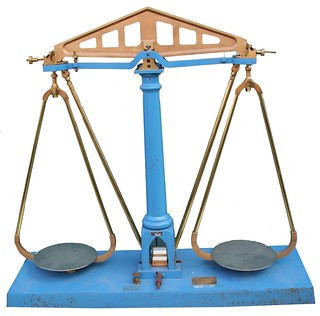
Very fine 500 troy ounce bullion scale made by Trommner of Philadelphia for the US Mint. SN 10-57-13, CAD 084500, Model 751. Blue paint on base as original. Approximately 50" long, 3.5' high, 14" deep. This is a bullion scale made for the US Mint, perhaps within ten or twenty years of the demonetization of silver in 1964. This is a historic rarity in any form, and a great display piece for any museum, major numismatic collection, or mining office.
Provenance: Fred Holabird Collection
Exactly - great decorative (and functional!) addition to a numismatic library as well. -Editor
To read the complete lot description, see:
Trommner 500-Ounce Bullion Scale, Philadelphia Mint (82912)
(https://holabirdamericana.liveauctiongroup.com/Trommner-500-Ounce-Bullion-Scale-Philadelphia-Mint-82912_i38149279)
Lot 3435: D. K. Nichols Masonic Trade Token
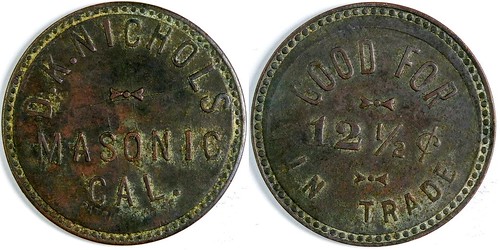
This is the first time to our knowledge of a public auction of the ultra rare Masonic trade token. D. K. Nichols/Masonic/Cal.// GF/ 12 1/2c/ IT. Rd, br, quater size. Masonic was a tiny mining camp near Bodie, Calif. , between Bridgeport and Bodie. The district was reportedly discovered in the 1860's and died out just after this token was made for Nichols.
To read the complete lot description, see:
Masonic, Cal. Trade Token, Ex Rare, Nichols (121661)
(https://holabirdamericana.liveauctiongroup.com/Masonic-Cal-Trade-Token-Ex-Rare-Nichols-121661_i38149464)
To read the earlier E-Sylum article, see:
HOLABIRD AUGUST 2020 SALE SELECTIONS
(https://www.coinbooks.org/v23/esylum_v23n33a23.html)
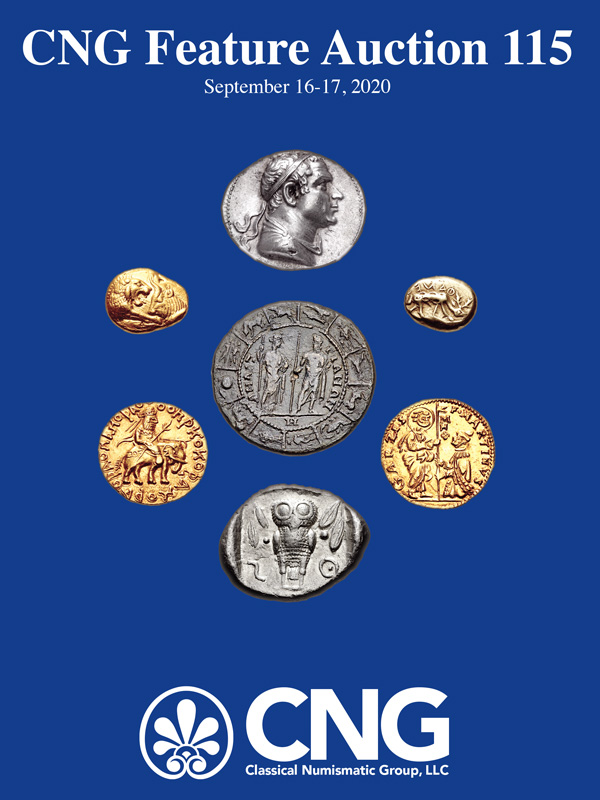
NUMISMATIC NUGGETS: AUGUST 23, 2020
Here's a selection of interesting or unusual items I came across in the marketplace this week. Tell us what you think of some of these. -Editor
1839 Adam Eckfeldt Retirement Medal
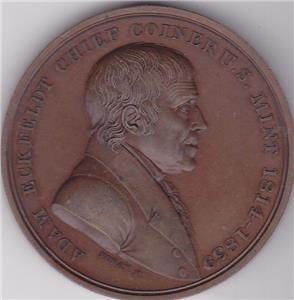
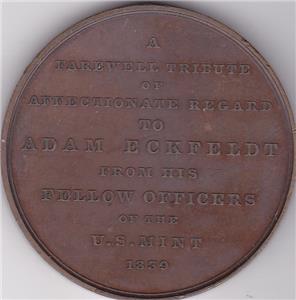
1839 Adam Eckfeldt Retirement Medal MT-18 CHIEF COINER U.S. MINT This auction is for a 1839 Adam Eckfeldt Retirement Medal MT-18 CHIEF COINER U.S. MINT Mortiz Furst, The obverse bears Eckfeldt's bust facing right, ADAM ECKFELDT CHIEF COINER U.S. MINT 1814-1839 around
"Adam Eckfeldt was born in 1769 and entered the mint service in 1792. In 1814 he was appointed chief coiner, a post he held for 25 years. Even after his official retirement, Eckfeldt continued coming to the mint daily and actually superintended the coining department for his successor, Franklin Peale. He died in 1852." Source - coinbooks & Katie Jaeger
Nice medal for a great numismatic personality well known to bibliophiles. -Editor
To read the complete lot description, see:
1839 Adam Eckfeldt Retirement Medal MT-18 CHIEF COINER U.S. MINT
(https://www.ebay.com/itm/124306447830)
1864 Seated Quarter
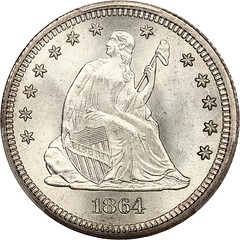
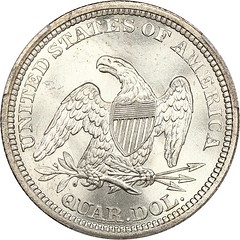
Wow! An absolutely stunning gem of this no motto Civil War date Seated quarter. Frosty, brilliant surfaces with just a light touch of golden iridescence that adds to the already astonishing eye appeal. Nearly flawless with an exceedingly sharp strike. CAC approved for quality. PCGS+ grade for premium quality at the top of end of the assigned grade.
From the David Lawrence Rare Coins site. This is indeed a gorgeous coin. I second that "Wow!". And check out their new viewing option - "NuTilt", an animated .gif of the coin being tilted like you would do with it in your hand to see the reflection from multiple angles. Nice feature! -Editor
To read the complete lot description, see:
1864 25c PCGS/CAC MS67+
(https://www.davidlawrence.com/rare-coin/2120244)
To see the NuTilt image, see:
https://www.davidlawrence.com/tiltview.html?cert_id=24809419&referrer_id=dl
Proof Washington Quarter Error
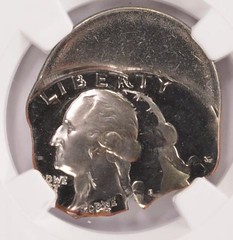

NGC Proof Washington Quarter double-struck overlapping, with each strike 35% off-center. An amazing proof double-strike off-center quarter, with very dramatic overlapping strikes! The coin's mintmark "S" is visible.
Major striking errors are rare on proof quarters because of the high quality controls and because it is tough for them to get out of the Mint if they are larger than the proof sets or that they are shipped in. However, many rarities such as most U.S. patterns, the 1913 nickels, and more have made it out of the Mint through one means or another, and all are highly valued by the collecting community today (and for good reason.) A rare opportunity to own a major striking error on a proof quarter.
PF68 Star with frosted devices and mirrored fields.
From Jon Sullivan's website. -Editor
To read the complete lot description, see:
ngc 25c proof washington quarter double-struck off-center and overlapping pf68 star
(https://www.sullivannumismatics.com/coin/ngc-25c-proof-washington-quarter-double-struck-center-and-overlapping-pf68-star?v=6470)

COIN CASTING AT COLONIAL WILLIAMSBURG
The Summer 2020 issue of the C4 Newsletter from the Colonial Coin Collectors Club featured an article by Jeff Rock about coin casting at Colonial Williamsburg. With permission, we're publishing an excerpt here. Thanks to Jeff and editor Will Nipper for making the text and images available. -Editor
By Jeff Rock
In the Winter, 2017 issue of C4N, I wrote about a trip to Colonial Williamsburg and urged readers who haven't gone to make time for a visit. I was set for a repeat visit in March of this year, after the Baltimore coin show – but a virus had other ideas, closing that show and Williamsburg too. There are always silver linings though, and since I couldn't go for an actual visit, I looked at some photos of my trip and reread the article I wrote. Imagine my surprise when I found I had promised a second article – which I had promptly forgot about when something shiny diverted my attention. Squirrel! So, a few years late, here is the promised follow-up article, dealing with the numismatic items actually made at Colonial Williamsburg, at a working foundry that uses only period-appropriate tools and methods of production. To save readers from hunting through their back issues, allow me to reprint my introduction to the foundry, built behind the James Geddy house in that city:
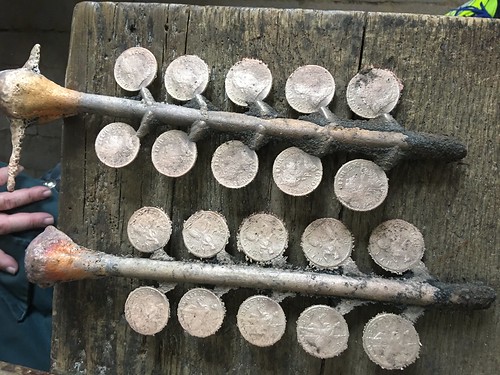
Two of the casting trees, each with 10 cast halfpennies still attached. All were made using a single regal 1771 British halfpence in the collection of Mike Noftsger – and as making the molds does not injure the original in any way, that single coin could literally be the progenitor of thousands of cast copies.
The foundry is ably run by Mike Noftsger (nicknamed "Lob" since his face usually takes on the color of a well-cooked lobster after working over the blazing fires used to melt various metals) and Susie Dye, and today turns out spoons, buckles, candlesticks, knobs, bells and other things appropriate for the time, making items in bronze, brass, pewter and silver, many of which are sold in the shops nearby. The process is in-house, literally from start to finish. Scrap metal is heated over a large furnace, the flames not produced by gas but painstakingly started and fed with wood and coal, as would have been done 250 years earlier. The molds are made in the type of sand that would have been available, hand framed in wood, and the tools used in every step of the process are historically accurate. When the metal is melted and reaches the correct color (the only way to tell its temperature in the 18th century) it is poured into the molds, allowed to cool, and then the cast products are broken out, cleaned and polished by hand. Had one of the Geddys suddenly materialized in the foundry he would have been able to get straight to work – though he might be confused by the oddly-dressed people holding up cameras and phones to record his progress!
While the foundry makes casts of the every-day objects that would have made 18th-century life more palatable, they also occasionally make casts of coins, some of which are available for sale in a few of the small stores found mainly on Duke of Gloucester Street. Sadly – or thankfully, depending on your math skills – Colonial Williamsburg isn't making you pay for souvenirs, food or drink in Pounds, Shillings and Pence once you are inside their living museum, or ask you to figure the trade value of a clipped Pine Tree shilling or an irregularly cut Spanish 8 Reales using an almanac of values and a pair of handheld balance scales. They aren't even asking you to discern between regal and counterfeit halfpence in calculating their value in a transaction. While the chip-reading credit card machines make life a lot simpler than 18th-century shoppers would have had it, I suspect many numismatists would have enjoyed the experience – but probably just once.
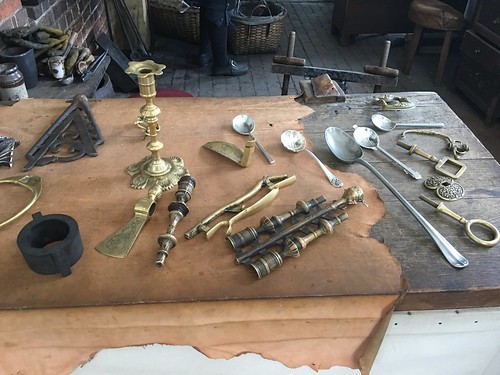
All of the objects on this table were made by casting at Colonial Williamsburg.
For more information about the Colonial Coin Collectors Club, or to join, see:
https://colonialcoins.org/
For more information on Colonial Williamsburg, see:
https://www.colonialwilliamsburg.org/
To read the earlier E-Sylum article, see:
PERIODICAL: C4 NEWSLETTER SUMMER 2020
(https://www.coinbooks.org/v23/esylum_v23n33a08.html)
THE HEATON MINT SERIES OF CHINESE COINS
Stack's Bowers Senior Numismatist and Cataloger Jeremy Bostwick published a blog article last week on the Heaton Mint Series of Chinese coins. -Editor
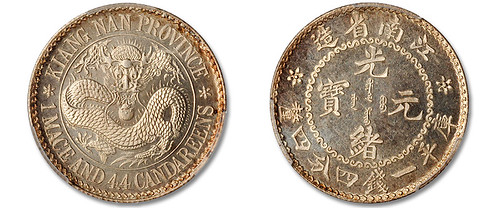
Late in the 19th century, China began to modernize their coining system, moving away from the cast "cash" coinage that had been standard for over two millennia, and toward a denominated rubric more in line with the western world. Various provincial mints began striking the "7 mace 2 candareens" denomination—corresponding to the Mexican 8 reales, American dollar and other similar crown sized silver issues—along with its respective minors. Copper issues were also produced, but often featured designs akin to their silver counterparts instead of those with central holes that had been used on the longstanding cast coinage. Though many of these "new style" coins were struck with locally produced dies, the mint in Nanking (within Kiangsu province) specially commissioned Ralph Heaton's mint in Birmingham, England in 1897 to produce the dies for a set of silver denominations. As the province wanted to denote these differently than their copper issues struck, the regional name of "Kiangnan," no longer extant as an official province, was utilized for the silver set.
The Heaton mint produced a series of five denominations—"dollar," "50 cents," "20 cents," "10 cents," and "5 cents," all struck in low mintages and at a specimen quality standard. The mint then sent these specimen sets along with the dies to Nanking where future issues could be produced. Within the series of Chinese 'dragon' coins, the dragon created by the Heaton mint stands out for its more intense, somewhat anthropomorphic style, featuring a dragon with rather large, piercing eyes, a more pronounced snout, and clawed forearms ready to pounce. Once observed, this "Heaton style" dragon is instantly recognizable and serves as a highlight in any collection.
Our upcoming October Hong Kong auction—set to be yet another incredible offering with nearly 4,000 lots split between coin and paper sessions—will feature one of these exceptionally rare Heaton mint specimens: a "1 mace 4.4 candareens" or 20 cents. This mostly steel gray example, which has received the rather elite grade of SPECIMEN-67+ from PCGS, features mirrored fields, peripheries that present an intense mélange of champagne and magenta, and devices with just a hint of charming frosting. The only other example of the type seen at PCGS attained the level of a 64, so it is easy to see just how monumental this incredibly attractive pattern minor is.
To read the complete article, see:
The Heaton Mint Series from Old Kiangnan
(https://www.stacksbowers.com/News/Pages/Blogs.aspx?ArticleID=heaton-mint-series-from-old-kiangnan)

THE HISTORY OF HOBO NICKELS
Ed Krivoniak forwarded this article on the history of Hobo Nickels. Thanks. -Editor
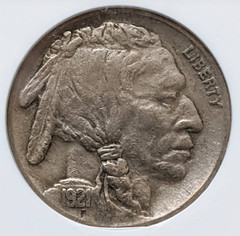
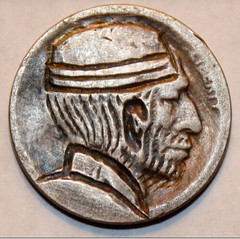
The first altered coins date back to the 18th century in Britain, France, and South Africa, where people engraved "love tokens" into silver. These metal emblems (usually etched with initials or names) were given as gifts and often incorporated into jewelry.
When the Buffalo nickel was introduced in 1913, it became the most popular surface for coin engravers in the U.S. While previous coins featured small heads (a Lincoln cent, for example, had a head covering about one-sixth of the area), the Buffalo nickel had a Native American's head that occupies about five-sixths of the coin's surface.
The large, thick metal template allowed more room for finer details and elaborate designs—a shift in convention. Nearly all older coins were adorned with female heads (such as the Liberty Head nickel). The male head on the Buffalo nickel, by contrast, had larger characteristics that allowed artists more space for altering the face into all sorts of characters, including skulls, self-portraits, or their friends. Even the reverse side of the coin (which features a buffalo) was often changed into another animal, such as a donkey or an elephant. Some artists went another route and turned it into a walking man wearing a backpack.
Regardless of the chosen design, artists spent hundreds of hours using chisels, knives, hammers, and any other object fit for shaping and etching metal.
These American hobo nickels started to emerge all over the country, and more and more people started to adopt the craft as the years went by.
During the 1930s, the Buffalo nickel remained the most popular among engravers, and many of the early coin engravers continued to prefer the classic coin after it was replaced by the Jefferson nickel in 1938. From the 1940s, many new carvers appeared, and the design and subject matter of the coins began to change to reflect a contemporary style.
It's believed that as many as 200,000 classic hobo nickels were created from 1913 to 1980, and many modern artists continue to practice the craft.
To read the complete article, see:
Discover the Rich History of the Hobo Nickel and Meet the Artists Keeping the Craft Alive
(https://mymodernmet.com/hobo-nickel-art/)

DO WE CALL THEM SO-CALLED DIMES?
Here's an interesting article by Paul Williams inspired by part of the collection of author Benjamin Fauver, which is being sold by Holabird Americana. Here's an except - see the complete article online. -Editor
Dime Sized Counters or Small Tokens?
by Paul Williams
 The So-Called Dollar term was invented because the
medals defined by it are all the size of the most popular
US coin of all time- the Silver Dollar. The unintended
consequence of a popular coin is that other similar
metal pieces will follow of the same size. Why not? Its
everybody's favorite.
The So-Called Dollar term was invented because the
medals defined by it are all the size of the most popular
US coin of all time- the Silver Dollar. The unintended
consequence of a popular coin is that other similar
metal pieces will follow of the same size. Why not? Its
everybody's favorite.
Benjamin Fauver had a box in his collection labeled "So-Called Dimes." In it were a series of dime sized tokens that fit the definition of the "So-Called" part of "So-Called Dollars." The tokens are all exposition commemorative pieces, but all dime (18mm) sized. But So-Called Dimes? The humble dime is in our culture: "Somebody Loan Me A Dime," a "dime-a-dozen". "Brother, Can You Spare a Dime?" is one of the best known songs from the Great Depression.
Harold E. Hibler and Charles V. Kappen wrote the book on So Called Dollars in 1963, and defined their focus: "This present work is restricted to medals of an exposition, commemorative, monetary and kindred nature. ...From the beginning, however, it was necessary to establish the following specific limitations in order to contain our efforts within a manageable perimeter." We can imitate the parameters of a SoCalled Dollar:
1. United States only
2. Minimum and maximum: 16-20 mm.
3. Looped material is essential as many were made to be worn. (Very few So Called Dollars have loops as they were heavier to wear.)
4. No plastic, fiber or similar material because they are metal.
5. No political medals.
Enough with the rules. The medals in the Fauver Collection are mostly 18 mm: the same size as a dime. Each are commemorating an exposition or commemorative event.
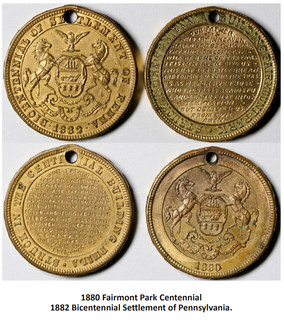 Most of these pieces are rare and die sinkers are hard
to identify. James Murdock Jr. of Cincinnati sold his
medalets at various fairs throughout many states surrounding Ohio. In the 1890s he used a stock die with the entire Lord's Prayer on the reverse. Several examples are in the Fauver Collection. The 1876 Centennial
in Philadelphia produced a medal with the Prayer on
the reverse. Henry Kettle of Birmingham England also
produced Lord's Prayer medals. In America the Lord
"Who Art In Heaven" and in Britain the Lord "Which
Art In Heaven." Wiley W. Osborne bought Murdock's
business so it became the Osborne Coinage Company,
a still operating private mint.
Most of these pieces are rare and die sinkers are hard
to identify. James Murdock Jr. of Cincinnati sold his
medalets at various fairs throughout many states surrounding Ohio. In the 1890s he used a stock die with the entire Lord's Prayer on the reverse. Several examples are in the Fauver Collection. The 1876 Centennial
in Philadelphia produced a medal with the Prayer on
the reverse. Henry Kettle of Birmingham England also
produced Lord's Prayer medals. In America the Lord
"Who Art In Heaven" and in Britain the Lord "Which
Art In Heaven." Wiley W. Osborne bought Murdock's
business so it became the Osborne Coinage Company,
a still operating private mint.
The collection of collector Benjamin Fauver represented 23 different states, with California being the most prolific. Expositions became popular after the success of the 1893 Columbian Exposition: The Chicago World's Fair.
To read the complete article, see:
Do We Call Them So-Called Dimes or
Dime Sized Counters or Small Tokens?
(http://s3.amazonaws.com/auctionmobility-wordpress-node-4/wp-content/uploads/holabird/2020/08/19195705/PW-DCD-article.pdf)
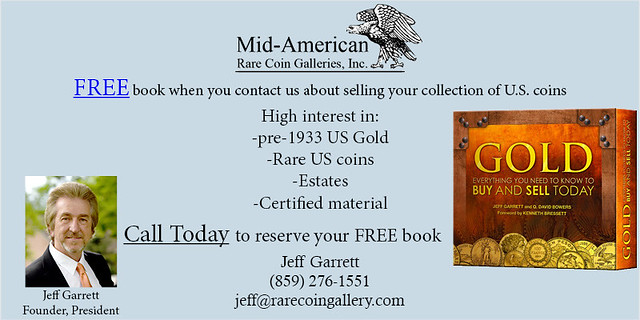
AN ESSAY ON GAMING COUNTERS
And here's another interesting article inspired by the impressive Ben Fauver collection being auctioned by Holabird Americana: a 16-page essay by Fred Holabird on Gaming Counters. Here's an except - see the complete article online. -Editor
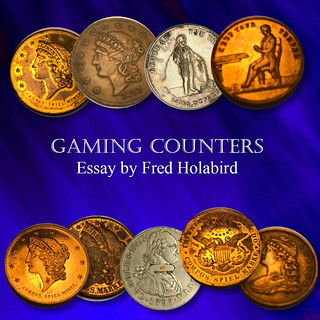 Abstract
Abstract
Gaming counters are the historical precedent to today's
gaming chips and tokens widely used in Casinos around the
world. In use since the 1200s, the genre has changed with
time and cultures. The study of American counters was undertaken by numismatist Benjamin Fauver who published
nine books on the subject. Fauver's personal collection
provides an important window into the study of the manufacture, distribution and use of many of these counters.
American counters come in many forms from many different die sinkers from several different countries over a wide span in time. Their use was ostensibly for a variety of card games, which may have begun with Whist, a form of Bridge as we know it today. Originally a western European game, it worked its way into America but was never as popular as it was in Europe. Instead, forms of poker took over, still prevalent today.
During the course of study of counters, some glaring anomalies arose, true mysteries that became the source of questions and intrigue.
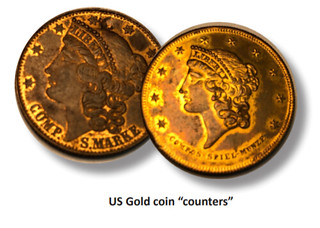 This paper aims to lay out a general discussion of counters: where they came from, how they were used, who
made them, how they were distributed and other factors.
Part of the discussion is the use of Fauver's catalogs, something quite difficult for the average numismatist. Following
the general discussion is an outline of the questions that
arose from the research. The key questions of interest are
"Why and when were US gold coin look-alikes made?"
"Where were they distributed, and under what circumstances?" These important questions have never been
asked or contemplated in published works.
The findings are surprising, even possibly controversial.
This paper aims to lay out a general discussion of counters: where they came from, how they were used, who
made them, how they were distributed and other factors.
Part of the discussion is the use of Fauver's catalogs, something quite difficult for the average numismatist. Following
the general discussion is an outline of the questions that
arose from the research. The key questions of interest are
"Why and when were US gold coin look-alikes made?"
"Where were they distributed, and under what circumstances?" These important questions have never been
asked or contemplated in published works.
The findings are surprising, even possibly controversial.
Introduction
American Gaming Counters should be as widely collected as the US gold coins they mimic. Unfortunately, overall
they are rare. Today, the main reason they are rare is that
Benjamin Fauver fell in love with the pieces, collected and
bought virtually every piece he could afford (circa 1970-
1992) and hoarded them with the ultimate goal of writing
and publishing the definitive collecting guidebooks, which
he did in 1989 with a series of nine books. Fauver bought
out nearly all the old collections, scoured coin shows, ran
advertisements and went after every collecting medium he
could think of to gather "counters."
The result was that Fauver collected thousands of pieces. He became fascinated with the source in antiquity of counters in western Europe and began collecting those too.
Over the years, as I became fascinated with these lookalike US gold coins and relics of the California Gold Rush gambling communities, our company(s) began acquiring them, first as a collection, then for resale. At the time, getting counters "slabbed" by third party grading services was almost impossible. While a few were listed in a number of important references such as Russ Rulau's massive token tome, most were unknown to the grading services, who did not have copies of Fauver's catalogs. My attempts at third party grading years ago were futile. We "typed" each piece we sent in, only to have the grading service completely ignore the Fauver "type" and catalog number. Days and weeks of study went completely down the drain. Fauver's guidebooks didn't help – they were privately published in small quantity, difficult to attain, and are complicated with very little discussion about the pieces themselves, something we all like to read and learn about.
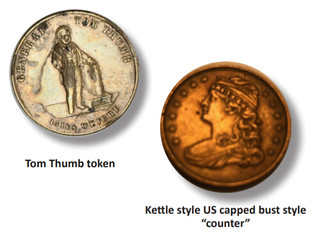 Today, there is better communication and understanding between all parties, and the problems we face in the
collecting community are much different. The biggest
problem was created by Fauver himself – he hoarded everything he could get, which removed competing collectors from the field, and the desire or demand for counters
fell dramatically. Today, we've seen this pattern far too
often- in the collecting fields of "western outlaws", rare
western photographs and many more fields, where one
very serious and enthusiastic collector in each field bought
everything, then quit collecting when the collecting goal
was achieved. The markets crashed right behind it.
Today, there is better communication and understanding between all parties, and the problems we face in the
collecting community are much different. The biggest
problem was created by Fauver himself – he hoarded everything he could get, which removed competing collectors from the field, and the desire or demand for counters
fell dramatically. Today, we've seen this pattern far too
often- in the collecting fields of "western outlaws", rare
western photographs and many more fields, where one
very serious and enthusiastic collector in each field bought
everything, then quit collecting when the collecting goal
was achieved. The markets crashed right behind it.
The remaining problem is obvious – market. The market for counters needs to be re-established. With the Fauver Collection, there are hundreds of pieces in mint states. Will they withstand the cost of third party grading and certification in the new market? In order to get these out in a timely manner, it became necessary to release them "raw." We have experimented with a number of certified and raw pieces placed into differing forms of numismatic auctions with very mixed results, that when looked upon analytically, make no sense. With this knowledge, we have chosen to "lot" the coins into specific small collections, highlighting several different facets of counters that could attract new and old collectors alike.
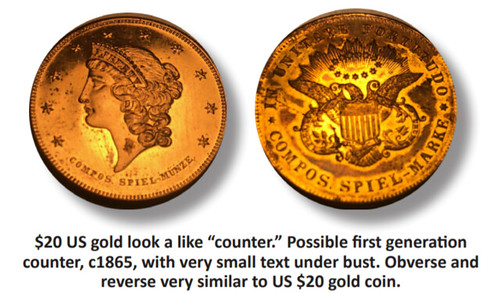
There is much, much more to Fred's great article, so be sure to read it all online. For bibliophiles, here's Fred's list of Fauver's books. -Editor
Fauver split counters into categories, choosing to create a number of separate works instead of a single volume. All were privately published and distributed by Fauver.
(no number) Exonumia, Symbolism and Classification (1982)
Part 1. Eagle and Double Eagle Gold (1983)
Part 2. Half Eagle Gold (1989)
Part 3. Three Dollar and Quarter Eagle Gold (1989)
Part 4. One Dollar Gold and One Dollar Silver (1990)
Part 5. Minor Denominations and Miscellany (1990)
Part 6. Latin America and Canada (1990)
(No number) A trial Listing of Recmenmeister/ A B C Counters of the 1500s (1990)
(no number) Early California Counters (1991)
To read the complete article, see:
Gaming Counters – An Essay
(http://s3.amazonaws.com/auctionmobility-wordpress-node-4/wp-content/uploads/holabird/2020/08/13175729/Gaming-Counters-Essay.pdf)

UTAH'S GOLDBACK ALTERNATIVE CURRENCY
Remember when Utah passed a Legal Tender act allowing gold currency? Here's one produce developed under its provisions: the "Goldback" alternative currency. -Editor
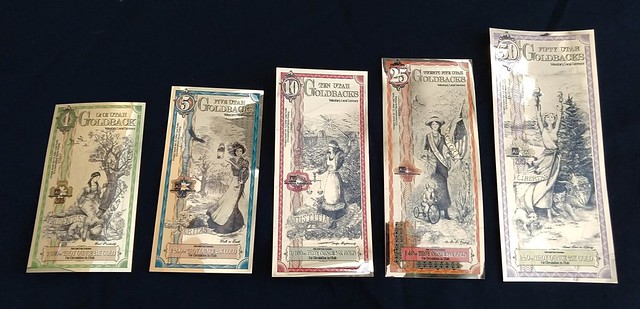
The Utah series was the first Goldback series available in 2019. Nevada and New Hampshire are scheduled to be done in 2020. There are many projects in the works. Goldbacks may be used anywhere people chose to accept gold.
The Goldback is the world's first voluntary, complementary currency to be made of a spendable, beautiful, small denomination, physical gold.
The Goldback project truly began in spirit with the passage of the Utah Legal Tender Act in 2011 which recognized certain types of Gold as currency within the state. Since that time the technology to mint gold into a spendable form for small transactions has come to fruition. Goldbacks may be used almost anywhere in the world for barter transactions. Goldback Inc. is using cutting edge vacuum deposition technology to circulate gold as it never has before.
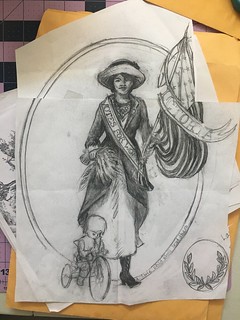 We are working to make it possible for an anyone to have a choice on whether or not they want their regular spending money to be subject to inflation. The Goldback is meant to be the best physical complementary currency for retaining value. Our goal is for people to be able to pay for anything with the Goldback whether it is a new home or a lemonade. Each Goldback is at least valued at the current rate on Goldback.com by businesses.
We are working to make it possible for an anyone to have a choice on whether or not they want their regular spending money to be subject to inflation. The Goldback is meant to be the best physical complementary currency for retaining value. Our goal is for people to be able to pay for anything with the Goldback whether it is a new home or a lemonade. Each Goldback is at least valued at the current rate on Goldback.com by businesses.
Some people feel like there may come a day when regular fiat currency will no longer retain much value due to some economic, political, or natural disaster. Over the past century hundreds of fiat currencies have had their values wiped out. For this reason, many people hold some amount of gold and silver. However, it may be difficult to spend a theoretical $1,500 gold coin or even an $80 silver coin for the purchase of toilet paper if an EMP blast wipes out the power grid for several months. It makes sense to keep a portion of this hedge in Goldbacks.
Our team has been working in the precious metals industry since our General Counsel, Lawrence Hilton, authored and championed the passage of the Utah Legal Tender Act in 2011. The Utah Precious Metals Association formed in 2012 from the "Citizens for Sound Money" and began offering legal tender gold accounts that same year. We have been innovating in the space ever since.
The site includes an interesting readable history of the notes, including the story of the artwork. I've excerpted some paragraphs below, bt it's all worth checking out, inluding the additional linked pages. -Editor
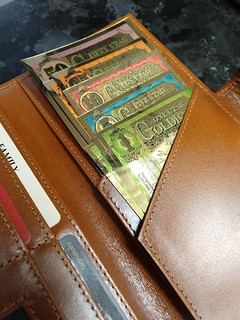 Every Goldback is a quarter inch taller than the previous denomination except for the ‘fifty', which has a half inch jump from the ‘twenty-five'. The ‘fifty' is also the only one that is 3 inches wide. We wanted the larger denominations to always be physically bigger than the smaller ones because it feels more intuitive to have it that way. Also, having different sizes makes each Goldback easier to identify when stacked on each other, and they are more friendly to the visually impaired. In fact, most countries use different size denominations for their currency. (But they don't use any real gold!!!)
Every Goldback is a quarter inch taller than the previous denomination except for the ‘fifty', which has a half inch jump from the ‘twenty-five'. The ‘fifty' is also the only one that is 3 inches wide. We wanted the larger denominations to always be physically bigger than the smaller ones because it feels more intuitive to have it that way. Also, having different sizes makes each Goldback easier to identify when stacked on each other, and they are more friendly to the visually impaired. In fact, most countries use different size denominations for their currency. (But they don't use any real gold!!!)
The first image for the ‘one' denomination was done (we thought) so we had it scanned and sent to Valaurum for the digital aspects of the art to be finished. Bonnie Edwards was/is the second artist. She designed everything on the Goldbacks that wasn't done by pencil, which is about half of what you see on the Goldback. She spent quite a bit of time on each denomination adding unique security designs, colors, and fonts to give the Goldbacks balance, continuity, and individuality. She also cropped and adjusted the pencil art so it would be displayed appropriately. Chris and I worked with Bonnie back and forth quite a bit, but oddly, Bonnie and Cheri only talked to each other only once or twice. It is interesting to note that the art on the Utah Goldbacks is of women and was drawn, designed, and put together by only female artists. We got the demos of the ‘one' about a month before Freedomfest. The ‘one' denomination was the most artistically challenging by far.
I don't fault anyone for being skeptical or worried about the possible negative repercussions of doing the Goldback. Chris and I were worried about even naming the currency a "Goldback" for fear of "the boogeyman." We knew what happened to the Liberty Dollar so we committed ourselves to studying that event so that we could avoid every mistake they made. We went as far as to read the entire 50 page case by the FBI against them.
The final task that was done during this timeframe was the creation of the Goldback wallet. This wallet is designed to fit Goldbacks so that they don't bend. Goldbacks can be bent, but that wears them out faster than necessary. The wallet was designed by our own Jeff McClellan who worked tirelessly with the manufacturers to get 800 said wallets produced. All of them have since been sold, and reorders have had to be placed.
Since that time, Goldbacks have taken the internet by storm on Reddit and YouTube. UPMA did a promotion offering a Goldback for a new account and they grew by 500% in just a few months; over 20,000 new accounts. Goldbacks are now offered by some of the biggest names in the industry, like APMEX and JMBullion. Goldbacks constantly sell out and they are the #1 most sought after small denomination gold product in America, according to some of our retailers. Our struggle now is keeping up with demand. Valaurum is constantly raising money so they can scale. It is hard to imagine the project turning out better.
To visit the Goldback website, see:
https://goldback.com/
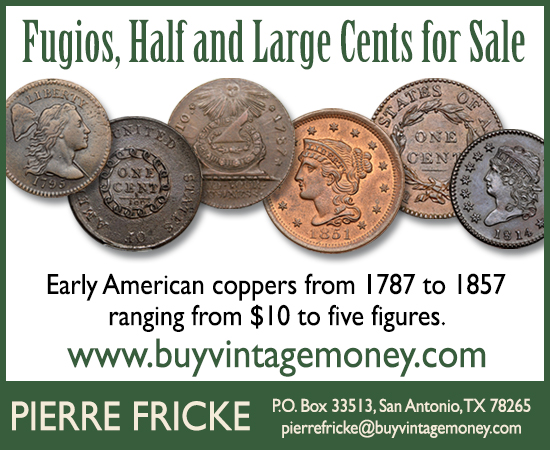
LOOSE CHANGE: AUGUST 23, 2020
Here are some additional items in the media this week that may be of interest. -Editor
Ancient Myths on Roman Coins
I missed this when it was published on August 4, 2020 - Elena Stolyarik of the ANS wrote about ancient myths on Roman Coins. -Editor
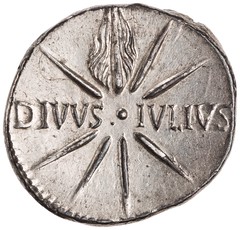 Many coins at the American Numismatic Society illustrate human interpretations of the universe and religious beliefs regarding human destiny. Among these are various samples from the ANS Roman collection having mythical and mythological themes.
Many coins at the American Numismatic Society illustrate human interpretations of the universe and religious beliefs regarding human destiny. Among these are various samples from the ANS Roman collection having mythical and mythological themes.
One of the great illustrations of astral imagery from the Early Roman Empire, strongly connected with Julius Caesar's heritage, is found on a silver denarius of Augustus struck circa 19–18 BC. This coin has the Emperor's image on the obverse and the famous Caesar's Comet on the reverse (fig. 1). The comet, which appeared some four months after assassination of Julius Caesar, was interpreted by the Romans as a sign of his deification and became a powerful symbol in the political propaganda of Augustus, Caesar's great-nephew and adoptive son.
To read the complete article, see:
ANCIENT MYTHS ON ROMAN COINS AT THE ANS
(http://numismatics.org/pocketchange/romanmyths/)
George Floyd and that $20 bill
In his blog The Rational Optimist, Frank Robinson addresses that allegedly counterfeit $20 that sparked the arrest leading to the death of George Floyd. Here's an excerpt. -Editor
It all started when a store clerk called police, accusing George Floyd of trying to pass a counterfeit $20 bill. In all the vast Floyd coverage, no one seems to have examined that $20 bill story.
But why?
Counterfeiting is actually a pretty elaborate operation, and nothing ties Floyd to a counterfeiting ring. If the bill was fake, the far likelier explanation is that Floyd himself was the innocent victim of someone else's passing it off on him.
I'd still like to know what happened to that $20 bill. Is it in an evidence locker? Has it been reviewed by the Secret Service? Where will it end up in the future? If genuine, returned to Floyd's family? Locked in an archive? A museum? A private collection? Maybe a FOIA (Freedom of Information Act) request could at least reveal the bill's photo or serial number. -Editor
To read the complete article, see:
George Floyd and that $20 bill
(https://rationaloptimist.wordpress.com/2020/08/17/george-floyd-and-that-20-bill/)
To read the earlier E-Sylum article, see:
COUNTERFEITS IN MILWAUKEE AND MINNEAPOLIS
(https://www.coinbooks.org/v23/esylum_v23n23a36.html)
Aquarium Waterfall Coin Count Announced
Remember the North Carolina aquarium that gathered up 14 years worth of coins tossed into a fountain? They finally finished counting them. -Editor
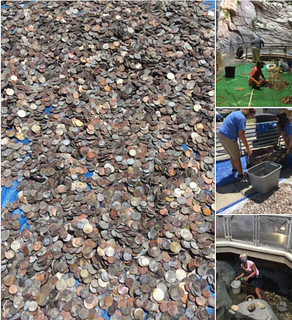 After weeks of cleaning and more than 10 hours of feeding coins into a bank's coin counting machine, the North Carolina Aquarium at Pine Knoll Shores knows how much in coins was sitting at the bottom of one of its water fixtures.
After weeks of cleaning and more than 10 hours of feeding coins into a bank's coin counting machine, the North Carolina Aquarium at Pine Knoll Shores knows how much in coins was sitting at the bottom of one of its water fixtures.
It wasn't quite in the six-figure range, as some had hoped, but the winning guess was only $1 short.
"Drumroll please … there was $8,563.71 in pennies, nickels, dimes and quarters," aquarium director Liz Baird said in a news release. Facebook user Amy Campbell had guessed $8,562.
The water fixture was installed in 2006 and became something of a wishing well over the next 14 years, the staff said.
When they finally drained the waterfall, the aquarium found 100 gallons of loose change — plus some "long-forgotten children's toys, pacifiers and military challenge coins" — sitting at the bottom.
Lonnie Burke, an aquarium security guard who helped lug the coins out, said the change was "more than a foot-and-half-deep" in some places.
To read the complete article, see:
Count is in for 100 gallons of coins found at NC aquarium. Winning guess was $1 short
(https://www.newsobserver.com/news/state/north-carolina/article245139705.html)
To read the earlier E-Sylum article, see:
AQUARIUM RAKES IN 14 YEARS WORTH OF COINS
(https://www.coinbooks.org/v23/esylum_v23n33a32.html)
Two Giant Gold Nuggets Found in Australia
Some guys have all the luck - two prospectors in Australia quickly found two monster gold nuggets. -Editor
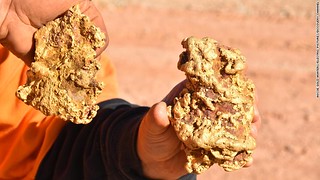 Gold diggers in southern Australia have found two huge nuggets worth $350,000 AUD ($250,000 USD) in historic goldfields.
Gold diggers in southern Australia have found two huge nuggets worth $350,000 AUD ($250,000 USD) in historic goldfields.
The pair of nuggets weigh in at a combined 3.5 kilograms (7.7 pounds) and were found on the same day near Tarnagulla in the state of Victoria, as shown on Thursday's episode of "Aussie Gold Hunters" on the Discovery Channel.
Prospectors Brent Shannon and his brother-in-law Ethan West found the nuggets in a matter of hours with the help of West's father Paul West, according to a Discovery Channel press release.
The pair had been waiting months for a permit that would allow them to start searching for gold in the area, according to the release.
To read the complete article, see:
Two giant gold nuggets worth $250,000 found in Australia
(https://edition.cnn.com/2020/08/20/asia/australia-gold-nuggets-scli-intl/index.html)
Is There a New Golden Rule?
Speaking of gold, Martin Kaplan passed along this NGC blog article including thoughts from multiple hobby leaders. Thanks, See the complete article online. -Editor
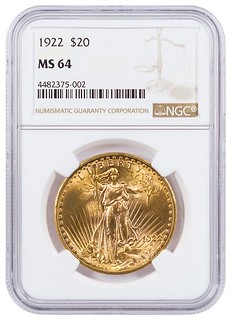 Gold trading above $2,000 is truly a significant milestone — one that finds the yellow metal enjoying a huge amount of well-deserved attention in the mainstream media. Many of us veteran numismatists knew this lofty summit would be achieved at some point, yet now that it is a reality, is there a new playing field and rules? Will this virtually unprecedented demand perhaps drive gold even higher and potentially out of the reach for many would-be collectors? So much excitement and so many questions.
Gold trading above $2,000 is truly a significant milestone — one that finds the yellow metal enjoying a huge amount of well-deserved attention in the mainstream media. Many of us veteran numismatists knew this lofty summit would be achieved at some point, yet now that it is a reality, is there a new playing field and rules? Will this virtually unprecedented demand perhaps drive gold even higher and potentially out of the reach for many would-be collectors? So much excitement and so many questions.
As the pandemic continues to wreak havoc on world economies, the oft referred to "safe haven" looks especially attractive. Gold is overwhelmingly the choice of many individuals and institutions seeking to preserve their savings, and they are scooping up gold bars and coins in record volume. For others — specifically we in the numismatic community — well, it just adds a bit of a higher price tag and another layer to the more bullion-related coins that we have been eyeing for our own collections.
To read the complete article, see:
Jim Bisognani: Is There a New Golden Rule?
(https://www.ngccoin.com/news/article/8517/)
Centuries-Old Find in Tudor Mansion
Bibliophiles and treasure hunters alike should enjoy this story from Norfolk, England. -Editor
While most of England was on lockdown amid the COVID-19 pandemic, archaeologist Matt Champion was working solo at Oxburgh Hall, a moated Tudor mansion in Norfolk.
As part of the site's £6 million (roughly $7.8 million USD) roof restoration project, workers had lifted the floorboards in the estate's attic for the first time in centuries. Probing the recesses beneath the boards with gloved fingertips, Champion expected to find dirt, coins, bits of newspapers and detritus that had fallen through the cracks. Instead, he discovered a veritable treasure trove of more than 2,000 items dating as far back as the 15th century.
The cache is one of the most remarkable "underfloor" archaeological finds ever made at a National Trust property, the British heritage organization says in a statement. Together, the objects offer a rich social history of the manor's former residents.
British nobleman Sir Edmund Bedingfeld built the manor house in 1482, reports BBC News. His descendants live in the home to this day.
To read the complete article, see:
Thousands of Rare Artifacts Discovered Beneath Tudor Manor's Attic Floorboards
(https://www.smithsonianmag.com/smart-news/thousands-rare-artifacts-discovered-underneath-attic-floorboards-tudor-manor-180975578/)
The Lost Colony of Roanoke Apparently Never Was (Lost, That Is)
This story from The Virginian-Pilot is non-numismatic, but should be of interest to history buffs and colonial coin collectors. -Editor
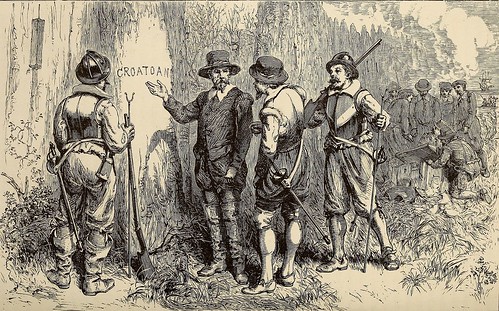
The English colonists who settled the so-called Lost Colony before disappearing from history simply went to live with their native friends — the Croatoans of Hatteras, according to a new book.
"They were never lost," said Scott Dawson, who has researched records and dug up artifacts where the colonists lived with the Indians in the 16th century. "It was made up. The mystery is over."
A team of archaeologists, historians, botanists, geologists and others have conducted digs on small plots in Buxton and Frisco for 11 years.
Dawson and his wife, Maggie, formed the Croatoan Archaeological Society when the digs began. Mark Horton, a professor and archaeologist from England's University of Bristol leads the project. Henry Wright, professor of anthropology at the University of Michigan, is an expert on native history.
Teams have found thousands of artifacts 4-6 feet below the surface that show a mix of English and Indian life. Parts of swords and guns are in the same layer of soil as Indian pottery and arrowheads.
The evidence shows the colony left Roanoke Island with the friendly Croatoans to settle on Hatteras Island. They thrived, ate well, had mixed families and endured for generations. More than a century later, explorer John Lawson found natives with blue eyes who recounted they had ancestors who could "speak out of a book," Lawson wrote.
To read the complete article, see:
‘The mystery is over': Researchers say they know what happened to ‘Lost Colony'
(https://www.pilotonline.com/news/vp-nw-not-lost-20200817-qgmblubzt5dyjm3jrcop25ssoq-story.html)
Another article:
The mystery behind the "lost colony" of Roanoke has finally been answered, disappointingly.
(https://boingboing.net/2020/08/18/the-mystery-behind-the-lost.html)
Noe to Marry Former Prison Guard
The Toledo Blade reported that coin dealer Tom Noe, recently released from prison, plans to marry a former prison guard. -Editor
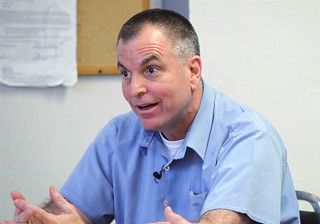 Tom Noe, the Coingate figure recently released from prison, is preparing to wed a former guard who worked at the southern Ohio state prison where he was once incarcerated.
Tom Noe, the Coingate figure recently released from prison, is preparing to wed a former guard who worked at the southern Ohio state prison where he was once incarcerated.
Noe, 66, applied Aug. 10 for a marriage license in Vinton County where his bride-to-be, Tammy L. Mitchell, 51, resides in Zaleski. She worked as a general activity therapist and then correctional officer at the Hocking Correctional Facility near Nelsonville, Ohio from 2004 until December, 2015.
After completing less than 12 years of an 18-year state sentence on theft and racketeering charges, Noe's sentence was commuted by Gov. Mike DeWine and he walked out of prison April 21 to return to the Toledo area. The release was primarily tied to the spread of coronavirus at Marion Correctional Institution, where he was imprisoned at the time, and came despite a unanimous recommendation from the Ohio Parole Board that he not be granted clemency.
Noe had been convicted of 29 charges, 25 of them felonies, for stealing $13.7 million from two rare-coin investment funds totaling $50 million that he managed on behalf of the Ohio Bureau of Workers' Compensation, the state-run insurance fund for injured workers.
To read the complete article, see:
Noe gets license to marry former prison guard
(https://www.toledoblade.com/local/courts/2020/08/18/tom-noe-gets-license-to-marry-former-prison-guard/stories/20200817108)
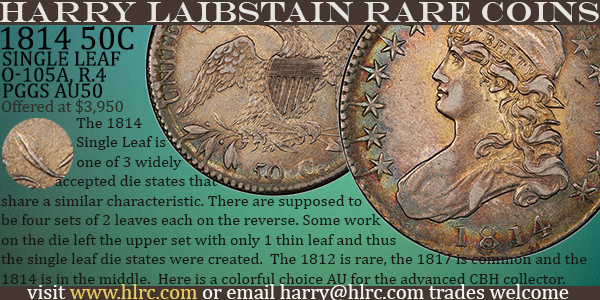
MR. SQUIRREL'S TIME-TRAVELING COIN ENVELOPES
Great Yarmouth is a seaside resort town in Norfolk, England. This article recounts the odd Twilight Zone story of a coin collector's shopping experience. -Editor
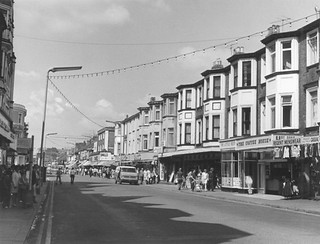 Can we really slip into another time zone as easily as we'd walk from one room to the next? The curious case of the Great Yarmouth shop with a ghostly assistant.
Can we really slip into another time zone as easily as we'd walk from one room to the next? The curious case of the Great Yarmouth shop with a ghostly assistant.
It was when he approached the till that he noticed the shop was strangely old-fashioned: despite it being 1973, the lady behind the desk was in Edwardian dress. The wonderfully-named Mr Squirrel had, according to an account in Norfolk author Joan Forman's book The Mask of Time, popped into a Great Yarmouth shop after a recommendation from a friend. This story is from sources which quote from Ms Forman's book, Legends and Things That Go Bump in the Night by S John Saunders and Norfolk Stories of the Supernatural by Betty Puttick.
Back to Mr Squirrel, who had stepped into the smartly-painted shop from a traditionally cobbled road and noted almost straight away that inside it seemed quaintly old-fashioned – inside there was complete silence, the traffic outside had melted away entirely. Keen to buy transparent envelopes to keep individual coins in, he went to ask for help at the till – a young woman stepped forward to help. She was wearing a blouse with a cameo brooch at her neck, her hair was scraped back into a bun and her skirt was long and swished to the floor. Mr Squirrel asked for the coin envelopes and she produced them, noting that they were also used by fishermen to keep their hooks in – he bought 36 for a shilling, nodded his thanks and left the shop.
Within a week, and having catalogued 36 coins, he found himself in need of more envelopes and set out once again for the old-fashioned shop. When he arrived, he was perplexed to see paving slabs instead of cobbles, a drab frontage instead of smart paint: inside, a much older woman stepped forward to serve him and, when asked for the envelopes, said she didn't stock them. Mr Squirrel mentioned the lady he had seen a week earlier only to be told that no such assistant worked at the shop – in fact, the lady he was speaking to was the sole assistant and had been for many years.
The story became even stranger: when Mr Squirrel took the envelopes he had bought on his first visit to an expert, they dated them and said they were around 10 to 15 years old, although did say that cellulose had been around since the 1920s. And then there was the question of payment: by 1973, decimalization had been introduced, although shillings were still legal tender with a value of 5p until December 31 1990. Mr Squirrel thought back and estimated that the shop seemed to be similar to those that were commonplace in the early 1900s... yet the envelopes were younger and the form of payment younger still.
Even rarer still in the cases of time slips: Mr Squirrel had brought something back, seemingly from another period of time entirely. Ms Forman suggested that Mr Squirrel had experienced a timeslip: his grandfather had also been a coin collector, and possibly might have visited the same shop. Were grandfather and grandson's memories merged? Or had Mr Squirrel simply visited two different shops and made a mistake? He was adamant this was not the case.
Everyone likes a good story, but curious about its background I reached out to UK reader and contributor David Pickup. -Editor
David writes:
"I have not heard this tale. There is a very similar H G Wells short story about a magic shop.
"I think someone is having someone on. If a friend recommended him to the shop what did they say about it?
"What is the expert in envelopes? I have never heard of an expert like this.
"I have never heard of anglers keeping hooks in plastic envelopes either or coin sized paper ones.
"Although 5 p was called a shilling in the 1970s the coin he used to pay to pay the ghost was unlikely to be an Edwardian one. What would the ghost do with the coin? Find a ghostly bank to pay it in? or a ghostly parking meter to pay for parking her ghostly carriage?
"A shilling in 1900 would be about £6.00 today which is quite a lot to pay for a few envelopes.
"The following is a story about "Ghost tours" being promoted in this seaside town."
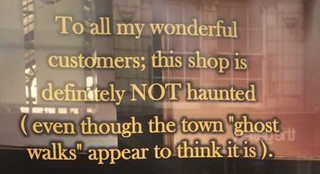 To read the "no ghosts here" article, see:
To read the "no ghosts here" article, see:
Great Yarmouth ghost claim rejected in sweet shop notice
(https://www.bbc.com/news/uk-england-norfolk-41551146)
To read the complete article, see:
WEIRD NORFOLK: A time slip in a Great Yarmouth shop and a spectral shop assistant
(https://www.edp24.co.uk/news/weird-norfolk-unexplaind-timeslip-great-yarmouth-1-6792691)
THE BOOK BAZARRE

